EDITION 143 - 2024
THE E-JOURNAL OF PORTS AND TERMINALS





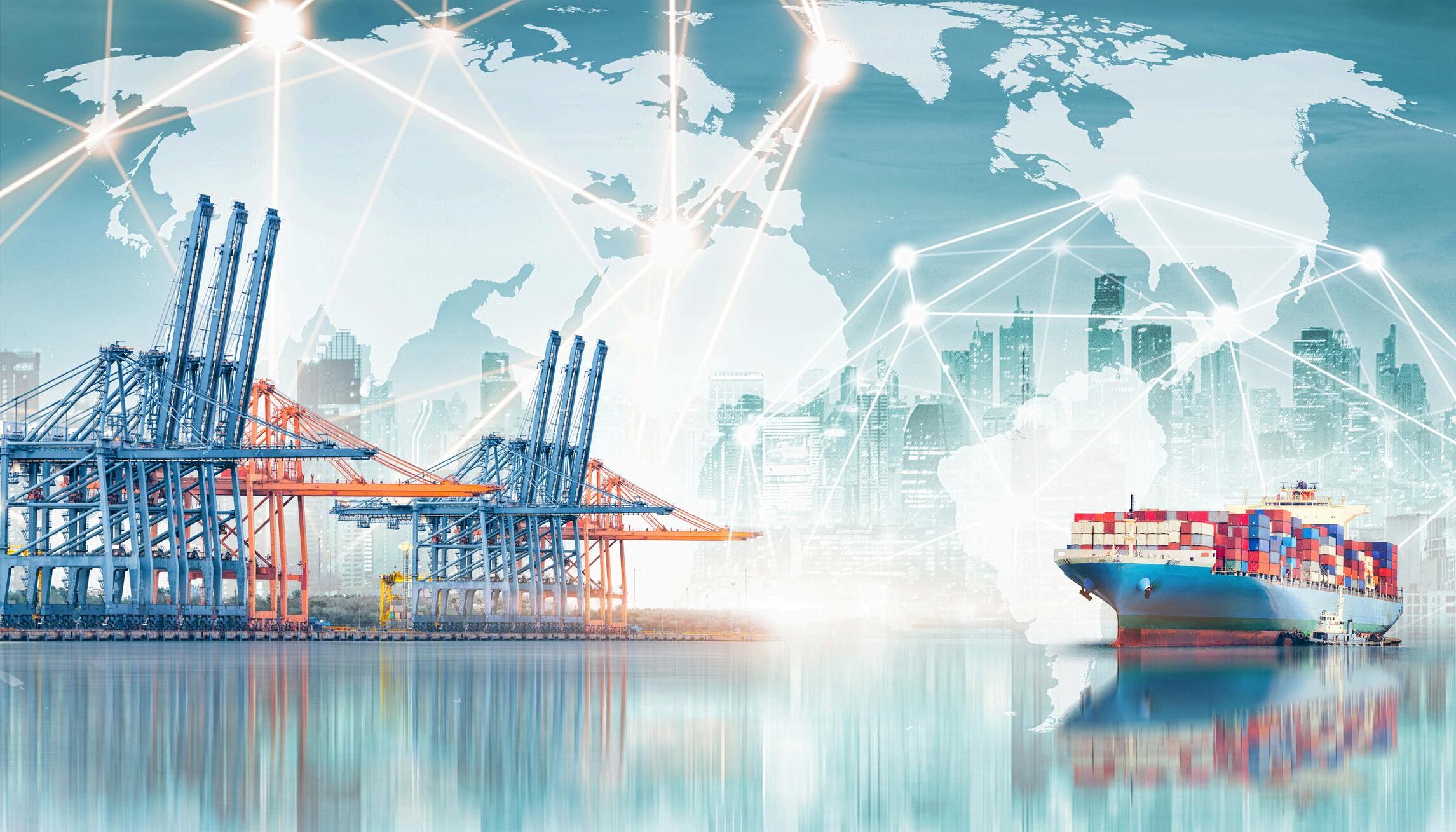
SDP Europe 2024 presents your annual opportunity to learn from the continents most innovative ports and forge new business partnerships.

Don’t miss this year’s progressive programme on smart port strategy and technology, alongside dedicated industry networking sessions.


Our 2024 Sponsors








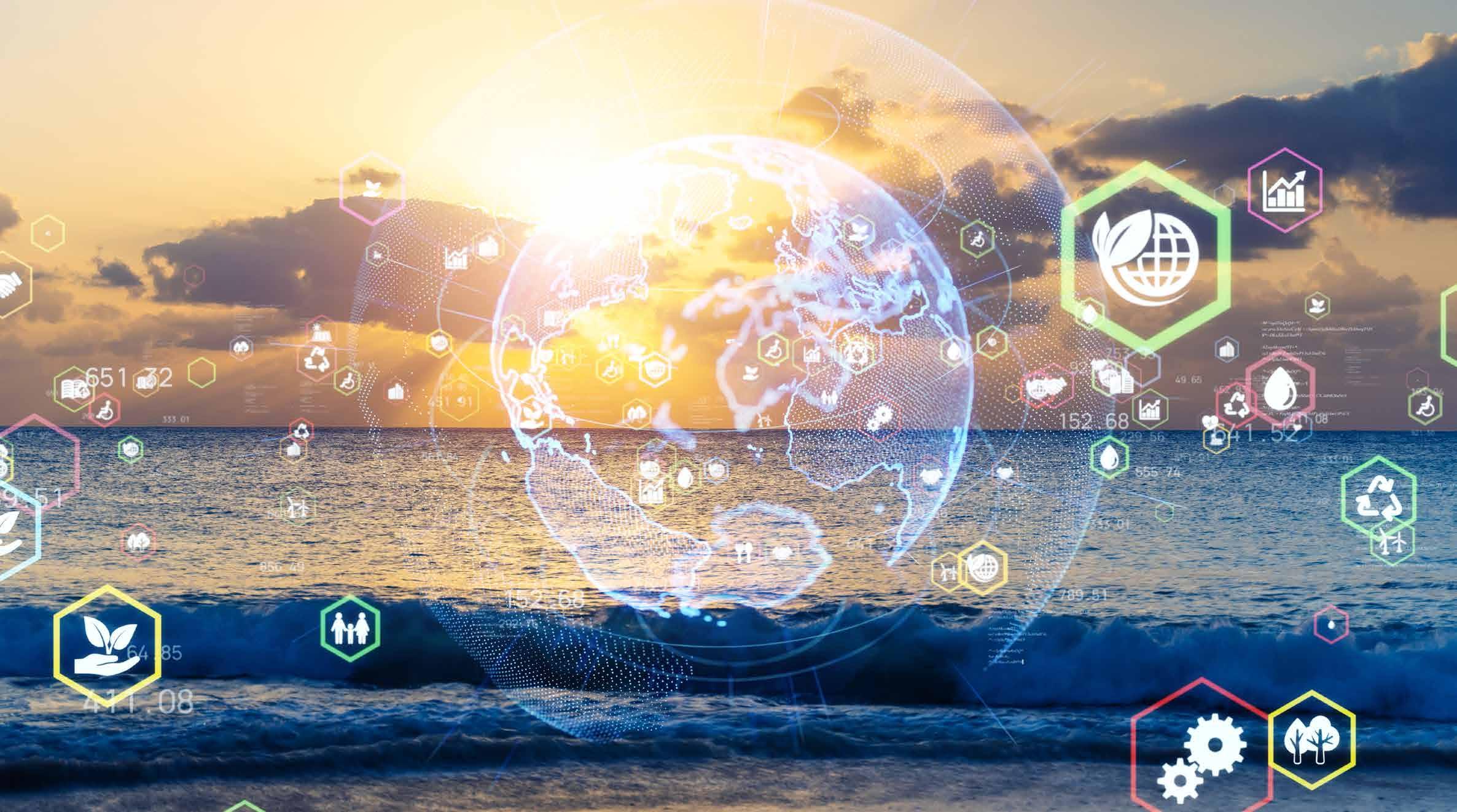
Welcome to the 143rd edition of PTI’s e-journal, where we delve into the latest trends in the maritime sector with insights from key stakeholders and forwardthinking innovators.
As summer fades, we focus on maritime sustainability, highlighting the green innovations shaping a net-zero future. Sustainability has become a significant topic in recent years, and PTI is dedicated to exploring the advancements driving the maritime industry toward greater ecofriendliness. Following our special May issue celebrating GreenTech 2024, we’re once again spotlighting the innovations and solutions propelling the maritime world towards a greener, more efficient, and cost-effective future.
We’re kicking things off with the Port of Halifax, our host for SDP North America’s debut last December. Recognising how essential ports are for global sustainability, the Port Authority has crafted a 2024–2030 Sustainability Strategy that aligns with the UN Sustainable Development Goals (SDGs). This strategy sets clear goals and is supported by rolling action plans and regular sustainability reports to keep progress on track and adjust as needed. Their agenda is designed to align the port's sustainability efforts with international standards while remaining
responsive to local needs and industry changes.
Dr. Mathias Dobner from BOXBAY is up next, sharing insights on their high-bay storage solutions. These are designed to boost efficiency in container handling and cut down on land use. BOXBAY’s technology is all about reducing energy use and supporting sustainability, with new projects in Europe and Southeast Asia on the horizon.
Hyster is pushing forward with electric and hydrogen-powered equipment. Their article covers how ports can get ready for these innovations by updating infrastructure and getting expert advice, as their advancements are paving the way for a clean energy transition.
Next, we’re very pleased to feature a report from the American Bureau of Shipping (ABS) on decarbonising US ports. The report points out challenges like poor infrastructure and funding gaps, and the need for cooperation between public and private sectors.
The move to electronic Bills of Lading (eBLs), driven by the Global Shipping Business Network (GSBN), is another big step forward to reducing paperbased documentation and promote decarbonisation. With blockchain technology and the FIT Alliance’s 2030
Margherita Bruno, Editor

target, eBLs are set to improve data security and efficiency and cut CO2e emissions by up to 440,820 metric tonnes each year. In their article, GSBN discusses how green fuels and blockchain are advancing sustainability.
Wolfgang Lehmacher and Mikael Lind return to our journal once more to also explore eBLs, acknowledging their benefits for sustainability but also noting challenges like regulatory fragmentation and outdated systems. Their contribution investigates various experiences in implementing electronic documents and elaborates on what is needed to accelerate the implementation across the globe and all modes of transport.
Finally, Nora von Xylander joins us with a look at marine habitat restoration and its impact on Marine Net Gain (MNG), carbon sequestration, and port decarbonisation. Her incredible piece sheds light on how restoring ecosystems like coral reefs, seagrass beds, and mangrove forests not only boosts biodiversity but also helps offset carbon.
We trust this journal will inspire meaningful discussions as effective collaboration and dialogue remain essential in the journey towards decarbonisation. Enjoy the read, and we look forward to welcoming you back in the next edition!
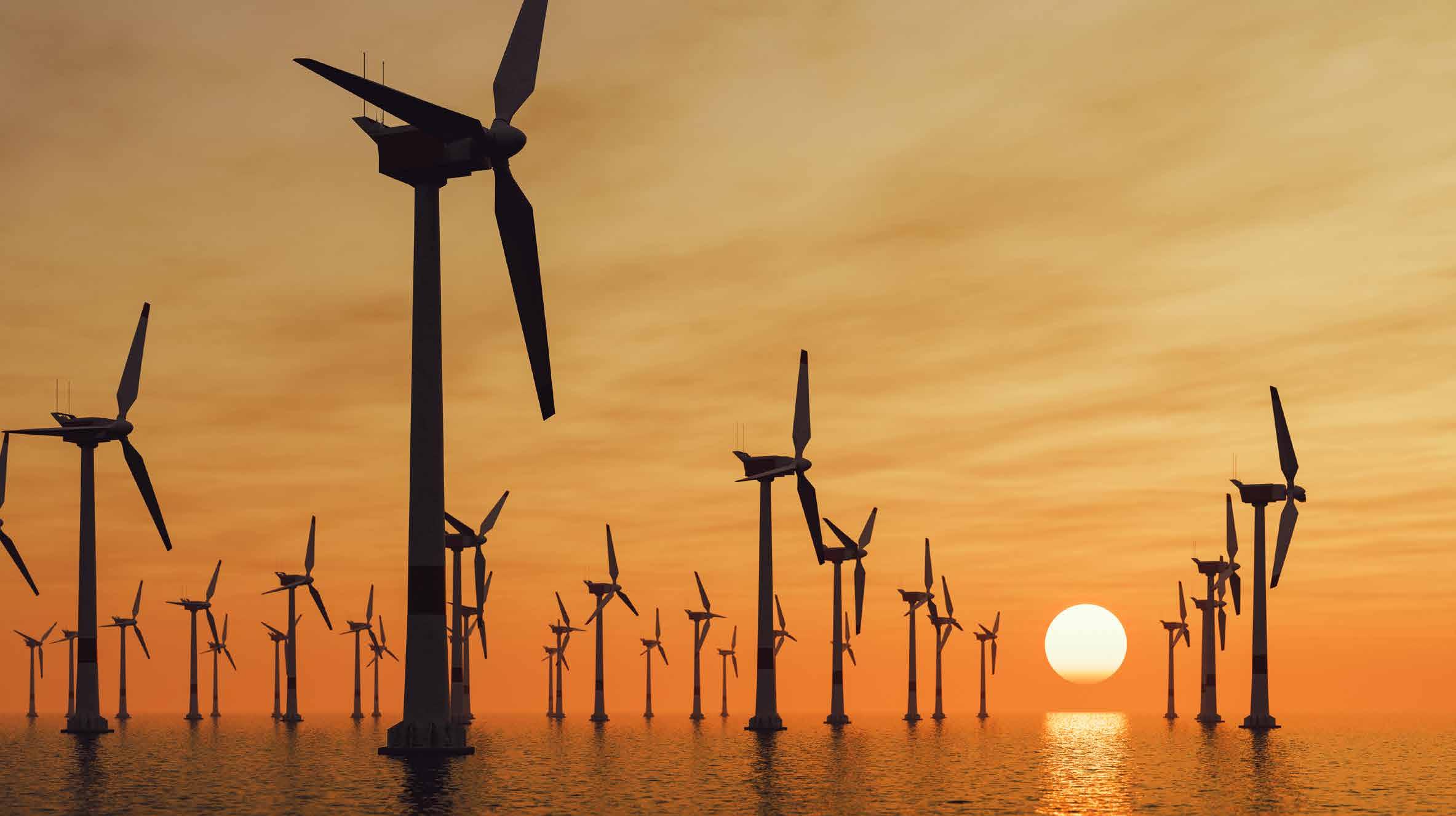
4.
DEVELOPING A PORT AUTHORITY’S SUSTAINABILITY STRATEGY: APPROACHES, LESSONS LEARNED & OPPORTUNITIES
Blair Crawford, Manager of Sustainability, Halifax Port Authority
9.
INNOVATING FOR A GREENER FUTURE: BOXBAY'S SUSTAINABLE SOLUTIONS
Margherita Bruno, Editor, Port Technology International, interviewing Dr. Mathias Dobner, Chairman, BOXBAY
14.
FOUR QUESTIONS WHEN CONSIDERING AN ELECTRIC FUTURE FOR YOUR PORT EQUIPMENT
Herman Klaus, Director, Application Solutions, Hyster
21.
DECARBONISATION POSES CHALLENGES AND OPPORTUNITIES FOR THE US PORT SYSTEM
Panos Koutsourakis, VP Global Sustainability, American Bureau of Shipping
26.
WHAT NVIDIA CAN TEACH US ABOUT THE SHIPPING TRANSITION TO NET ZERO?
Bertrand Chen, CEO, GSBN
30.
HOW TO ACCELERATE THE ADOPTION OF DIGITAL DOCUMENTS IN TRANSPORT AND TRADE
Wolfgang Lehmacher, Supply Chain and Technology Strategist, with Mikael Lind, Senior Strategic Research Advisor, RISE, and (Adjunct) Professor in Maritime Informatics, Chalmers
35.
THE POTENTIAL OF RESTORING MARINE HABITATS FOR MARINE NET GAIN, CARBON SEQUESTRATION, AND PORT DECARBONISATION
Nora von Xylander, Biodiversity Specialist & Sustainability Scientist, Tunley Environmental



Blair Crawford, Manager of Sustainability, Halifax Port Authority
It is widely recognised that the marine transportation sector’s efforts are critical to advancing global sustainability commitments such as the 17 UN Sustainable Development Goals (SDGs). As a key component of the global supply chain, ports have an instrumental role to play. Ports around the world are focused on decarbonisation, community relations, and environmental care initiatives and have reported on outcomes in sustainability reports.
The Halifax Port Authority (HPA), the Port of Halifax’s strategic port manager, has a mission to connect with global markets to create value for our customers, partners, visitors and community. We pride ourselves on being a future-focused organisation. The development of our 50-Year Plan, released in June 2022, was grounded in the principle of smart investment. The plan describes port planning to 2070 and considers various benchmarks to trigger expansion. In all port projects we undertake, our goal is to build smart by ensuring financial and environmental sustainability and complementing our surrounding community.
For the HPA, sustainability is the balance of economics, community, and the environment. It is central to our strategic vision, and we

embed this balance into all aspects of our organisation. To further our efforts, in June 2024, we launched our 2024 – 2030 Sustainability Strategy. The strategy lays out our high-level commitments and goals and is a tool to help us plan for, assess, and report on our work and performance.
We took a comprehensive and collaborative approach to develop our Sustainability Strategy, one that is grounded in industry best practices and insights from our people, partners, and community.
In the following article, we share how we developed the strategy, discuss the challenges we faced, what we’ve learned, and where we are going from here.
Learning from Others
We began with an industry scan. We wanted to learn from best practices across the marine transportation sector and develop a strategy that was grounded in an understanding of our industry partners’ ambitions and commitments.
We combed through the sustainability sections on numerous websites for Port Authorities across the world. Sustainability reports, frameworks, approaches, plans, and strategies offered crucial insights into what the term “sustainable” means to ports globally.
When we pivoted from research to writing we reviewed

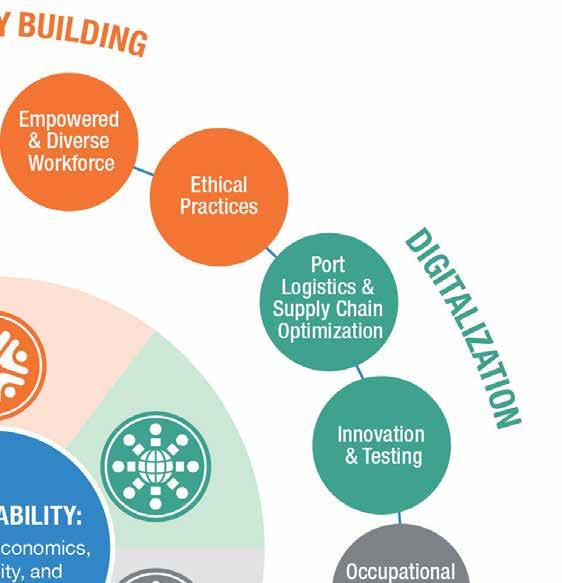
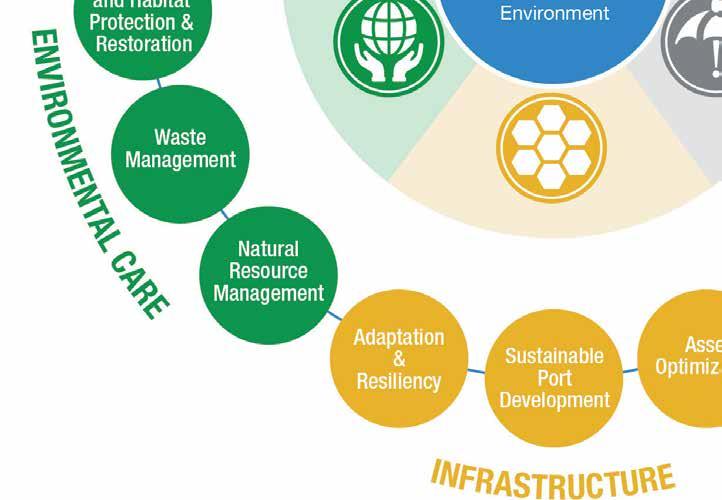

“WE TOOK A COMPREHENSIVE AND COLLABORATIVE APPROACH TO DEVELOP OUR SUSTAINABILITY STRATEGY, ONE THAT IS GROUNDED IN INDUSTRY BEST PRACTICES AND INSIGHTS FROM OUR PEOPLE, PARTNERS, AND COMMUNITY.”

The Halifax Port Authority’s new Sustainability Strategy is the port’s Sustainability Approach, based on the six themes of the World Ports Sustainability Program.
Ports Australia’s June 2020 resource titled Leading Practice: Port Sustainability Strategy Development Guide . This resource guided our next steps and is our recommended starting point for any port developing a sustainability strategy.
While drafting the strategy, the Sustainability Committee of our Board of Directors encouraged us to find ways to align our work to global sustainability frameworks. Our starting point was the World Ports Sustainability Program (WPSP). In 2017, the International Association of Ports and Harbors (IAPH) developed the WPSP, to highlight the global leadership of ports contributing to the SDGs. They set six key areas of interest: (1) Community Building, (2) Health Safety & Security, (3) Digitalisation, (4) Infrastructure, (5) Climate and Energy, (6) Environmental Care. The HPA has adopted the WPSP as the guiding framework for our Sustainability Strategy and we have identified focus areas, goals, and targets under each of the six themes to guide our plans and actions.
Children enjoy a sustainability activity during the Halifax Port Authority’s One Port City Day in June 2024. One Port City Day celebrates valued partnerships within the port industry and the broader community, coming together as One Port City.
We also looked closely at the specific targets and indicators of the SDGs laid out in the Global indicator framework for the Sustainable Development Goals and targets of the 2030 Agenda for Sustainable Development and The Canadian Indicator Framework for the Sustainable Development Goals . In doing so we sought to align our commitments to those set by the UN and Canadian Government in their frameworks. We found high alignment between our work and the Canadian Ambition statements laid out in the Canadian Indicator Framework, as shown in the “SDG Alignment” sections of our strategy.
By aligning our strategy to the WPSP and SDGs, we have identified how our efforts support industry and global standards and aspirations of sustainable practice.

“AT THE PORT OF HALIFAX, WE ARE GUIDED BY THE PRINCIPLE 'BE ONE PORT CITY'. WE KNOW THAT THE PORT AND CITY THRIVE WHEN WORKING TOGETHER.”
By being aligned, as we advance our sustainability commitments at the Port of Halifax, we will help contribute to the advancement of the global goals.
Listening to Our Community
At the Port of Halifax, we are guided by the principle “Be One Port City”. We know that the port and city thrive when working together, so we developed our Sustainability Strategy with the insights from our port community at the front of mind.
In 2021, we launched an extensive consultation and engagement process to understand the sustainability priorities of our community, partner organisations, and employees.
Based on this work, the HPA identified six SDGs connected to
our work and the priorities of our community, partners, and staff: (3) Good Health & Wellbeing, (8) Decent Work & Economic Growth, (9) Industry, Innovation and Infrastructure, (11) Sustainable Cities and Communities, (12) Responsible Consumption and Production, and (16) Peace, Justice and Strong Institutions.
Over the past several years, we have also been working to deepen our relationships with our community. In 2020 we launched our Port Community Liaison Committee (PCLC), which is our ongoing mechanism for communication and engagement between the HPA and the larger Halifax community. We’ve met with community groups, individuals and businesses, and have been fortunate to hear from hundreds of
ABOVE
Together with our partners at PSA Halifax and Seaport tenants, the Halifax Port Authority team collected ~210 kilogrammes of garbage for our Earth Day Clean Up in April 2024. That’s equivalent to 52 bags filled with debris, plus additional items like tyres and pallets. Our port community came together and made a tangible impact while keeping litter from ending up in Kjipuktuk, the Mi’kmaw word for the Great Harbour at Halifax.
people and organisations to help shape this work.
Learning from Our People
Organisational support is crucial for moving the needle on sustainability. Knowing this, we prioritised a collaborative approach to strategy development that involved every department at the HPA. Each department provided insights into the focus areas and goals and targets through a series of meetings to contribute insights and help us strike the right balance of practical and aspirational. Our Sustainability Strategy was ultimately signed off by the Sustainability Committee of our Board of Directors.
Once we launched the strategy, tailored meetings were hosted with every department to help all staff understand our sustainability
commitments and to highlight their roles and their department’s role to achieve our goals and targets. These meetings gave the entire HPA team an opportunity to ask questions, raise ideas, and ultimately see their work through sustainability lenses. Currently, we are collaborating with every department to set the path for how we will advance our sustainability commitments.
By engaging with and learning from our people, we created a holistic Sustainability Strategy that we believe has support across our organisation.
Commit!
The first draft of our Sustainability Strategy looked more like a plan. It outlined a series of actions and initiatives that we thought would help us achieve our goals and targets by 2030. While the projects and other elements that we laid out were valuable, they reflected our understanding of advancing our sustainability commitments at a moment in time. The world of sustainability is ever-evolving, and new technologies, best practices, and ways of thinking are constantly emerging.
Describing how you’ll achieve your commitments is important, but remaining open and flexible to new opportunities that may arise is critical too. Plus, trying to plan specific initiatives out to 2030 has the chance to result in a Sustainability Strategy becoming dated within a year of release. At the HPA we instead committed
to developing biennial rolling action plans to define “the how” of achieving our Sustainability Strategy alongside creating biennial sustainability reports to show progress towards our commitments. With this approach, we think we’ve struck the appropriate balance between commitment and flexibility.
When developing our Sustainability Strategy, we spent a lot of time thinking about success. We found it challenging to identify the right success metrics that were inclusive of our goals and targets without being too specific about the actions that we would need to implement to advance our commitments.
Throughout our strategy, you will see “Success Is” statements related to each of the key WPSP themes that guide our sustainability work. These statements aren’t your typical performance indicators. Since our Sustainability Strategy is focused more on our commitments than the actions, we decided to keep our success statements broad.
As we develop our biennial rolling action plans, we are committed to developing comprehensive performance indicators that closely align with the actions that will help us advance our sustainability commitments.
It’s our view that the development of biennial rolling action plans will evolve our Sustainability Strategy from aspirational to actual, and act as logical bridges to biennial sustainability reports. Both rolling action plans and reports will give
stakeholders a clear picture of sustainability progress at the Port of Halifax.
The sustainability journey for every port will be unique, and influenced by local priorities, stakeholders, and environmental contexts. However, our research, observations and experience suggest that a sound Sustainability Strategy, combined with rolling action plans and regular reporting, can act as a credible foundation for advancing a port’s sustainability commitments.
Blair Crawford (they/them) is the Halifax Port Authority’s Manager of Sustainability. They are responsible for developing and advancing the HPA’s 2024 – 2030 Sustainability Strategy. Blair joined the Port of Halifax in 2023 and brings with them experience in localising and advancing the UN SDGs.
The Halifax Port Authority stewards key federal infrastructure and waters at the Port of Halifax as spaces for economic growth, innovation, tourism, and community.
The port’s three main lines of business are cargo, cruise and real estate. Our deep harbour and advanced infrastructure mean that Halifax is the only Eastern Canadian port capable of accommodating Ultra Class ships and the largest container vessels to call at any port in Canada.
Sustainability is built into every facet of the port and how we operate.
www.porthalifax.ca
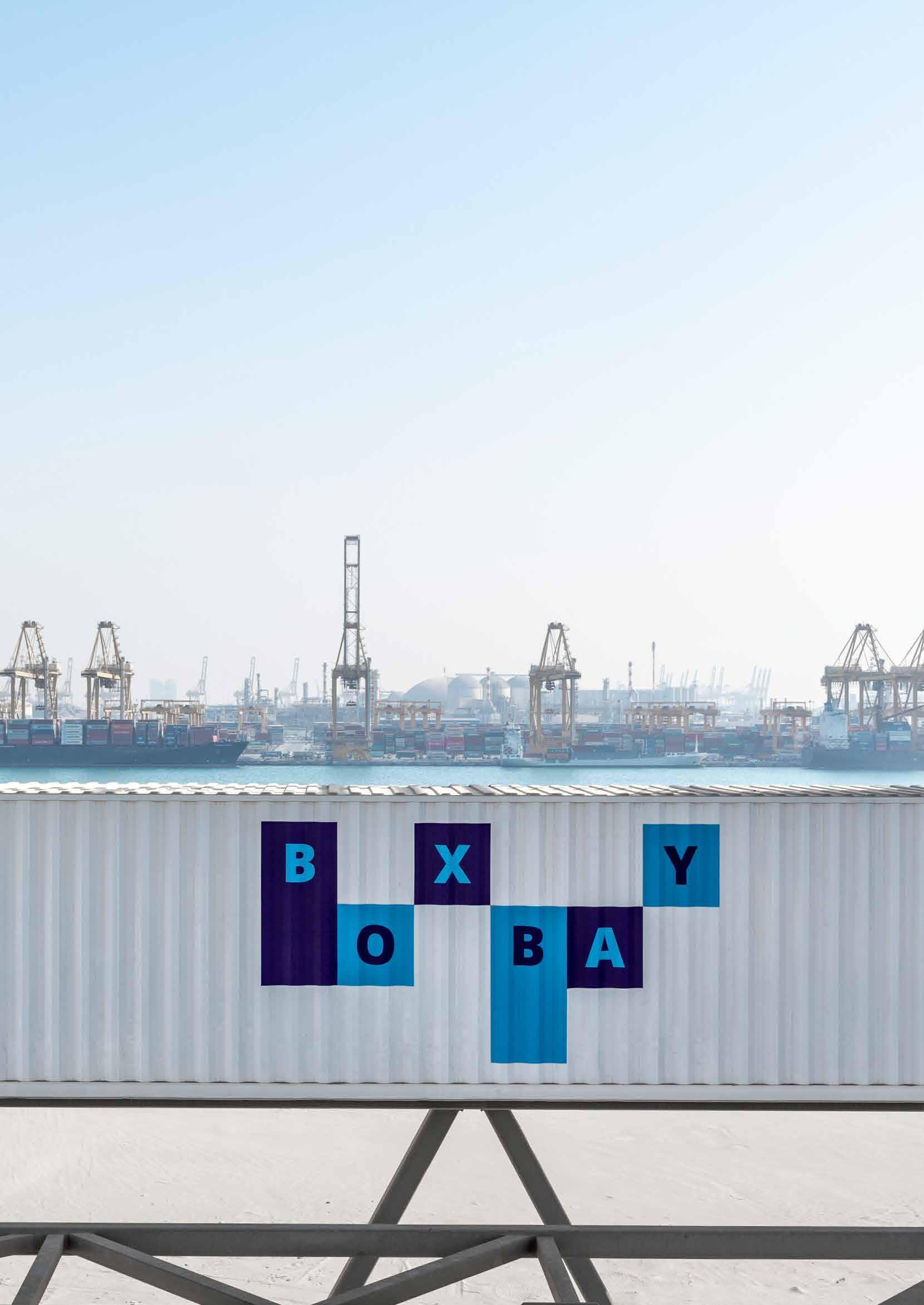



Margherita Bruno, Editor, Port Technology International, interviewing Dr. Mathias Dobner, Chairman, BOXBAY
Dr. Mathias Dobner discusses the strides BOXBAY has made in revolutionising container handling with its space-efficient high-bay storage solutions, the challenges of widespread adoption, and the company's commitment to sustainability. From reducing energy consumption and land use to exploring innovative applications, BOXBAY aims to lead the industry towards a more sustainable future.
Can you offer insights into the current progress and achievements resulting from BOXBAY's technology implementation across various ports? Are there any notable success stories or milestones you'd like to highlight?
Following our initial success published last year, we are once again on the brink of positive developments.
Currently, we are in discussions with a client about implementing a larger BOXBAY solution for an import/export terminal in the Southern Hemisphere. This terminal will focus on the full automation of material flow combined with our highly space-efficient high-bay storage solution for containers. Without BOXBAY, there would likely be no forward-thinking and viable alternative for this scenario. However, BOXBAY’s growth prospects are very promising.
Additionally, we are currently engaged in several other highly interesting and promising projects and have received numerous inquiries. Interestingly, these inquiries come not only from the seaport environment but also from

“BOXBAY PRIMARILY REPRESENTS A DISRUPTIVE AND FORWARDLOOKING HARDWARE SOLUTION FOR CONTAINER STORAGE.”
the logistics sector dealing with inland containers.
What are the primary challenges BOXBAY foresees in terms of further adoption and implementation of its high-bay storage solutions? How does BOXBAY intend to tackle these challenges?
The main challenge initially is to introduce BOXBAY through two-three successful projects worldwide. We are currently in this phase, and I am confident that we will overcome it successfully and positively.
With each project, the second challenge is always ensuring the correct scaling of the expansion steps—and we are in close developmental discussions and collaborations with several promising clients. This involves transitioning an existing brownfield terminal from a conventional operating system such as Straddle Carrier or RTG to BOXBAY. The first phase should not be too large to avoid disrupting ongoing operations but must be large enough to ensure that the second and third expansion phases can proceed without further disruptions.

With each additional project, our horizon expands, and we continuously encounter new and interesting ideas for incorporating additional value chains into the system, making it increasingly attractive. We have already developed a wide range of interfaces for various container transport modes and complementary system components, such as those for refrigerated containers. Additionally, we have introduced an "Aisle-Exchanger," which allows stacker cranes to be transferred from one aisle to another or from one building block to another, facilitating smooth transitions into subsequent expansion phases.
Looking at the future, what specific objectives or targets does BOXBAY aim to accomplish by the end of 2024? Are there
any particular markets or regions you're prioritising for expansion?
Our primary objective for 2024 is to secure another major contract for BOXBAY as just said, and from today's perspective, things look promising.
Currently, we are focusing heavily on Europe and Southeast Asia. We have opened an office in Singapore for the Southeast Asian market, led by Lim Meng Yong. Additionally, the US and Canada markets are very interesting for us, and we have specifically started to focus on this region this year.
Two months ago, our new employee, Peter Slootweg, moved into the US and has already established numerous contacts with terminal operators, consulting firms and domestic logistics companies, such as the US railway companies.
Could you elaborate on how BOXBAY's solutions contribute to the broader digitisation and automation of container terminals? How do you envision technology evolving within this sector in the near term?
BOXBAY primarily represents a disruptive and forward-looking hardware solution for container storage. A key advantage of BOXBAY is its ability to achieve extreme storage density and space savings, similar to the use of highbay warehouses in industry and other areas of logistics. Essentially, we are applying the high-bay warehouse concept to container terminals, which are always fully automated.
In a confined space, BOXBAY can accommodate three-five times as many containers as conventional container stacking solutions. Currently, the most advanced
“FURTHER AUTOMATION OF PROCESSES IN CONTAINER TERMINALS, AS WELL AS IN MANY OTHER LOGISTICS PROCESSES, IS INEVITABLE.”
solutions for container terminals, excluding BOXBAY, are terminals equipped with Automated Stacking Cranes (ASCs) and Automated Guided Vehicles (AGVs), which have been widely implemented over the past 20-30 years. These terminals, like BOXBAY, are also fully automated, with automated container storage and transport from the quay to the storage area, as well as truck loading on the landside.
The key difference with BOXBAY lies in the method and speed of container storage. BOXBAY provides direct access to each
container, unlike ASC terminals. This direct access eliminates the complex IT requirements and processes needed to continuously optimise the storage in conventional container terminals. Consequently, BOXBAY is fundamentally simpler in terms of IT and process optimisation efforts. In general, I believe that further automation of processes in container terminals, as well as in many other logistics processes, is inevitable. Automation will continue to streamline operations, reduce complexities, and enhance efficiency within the sector.

With the increasing focus on sustainability, how does BOXBAY ensure that its solutions align with these principles? Are there any ongoing initiatives or advancements in this sector?
I can confidently say that BOXBAY is by far the most advanced solution for container terminals in terms of sustainability and resource utilisation, including energy, maintenance, and land consumption. It is clear that eliminating the need to shuffle containers, which are typically
“BOXBAY IS BY FAR THE MOST ADVANCED SOLUTION FOR CONTAINER TERMINALS IN TERMS OF SUSTAINABILITY AND RESOURCE UTILISATION, INCLUDING ENERGY, MAINTENANCE, AND LAND CONSUMPTION.”
“BOXBAY CAN GENERATE FAR MORE ENERGY THAN IT CONSUMES. THE SURPLUS ENERGY CAN BE USED FOR OTHER ELECTRICAL PROCESSES WITHIN A CONTAINER TERMINAL, MAKING IT RELATIVELY EASY
stacked five, six, or even seven high, saves an enormous number of handling operations. This reduces both energy costs and machine wear significantly. Each storage and retrieval operation is only for the specific container needed, without the optimisation and reshuffling moves required by most other terminals.
In many container terminals today, there is an extremely unfavourable ratio of paid moves to forced reshuffling moves. I estimate that, on average, for a container yard stacked five high (one plus five), 40 per cent of all moves are so-called false moves. For six-high stacks, this number likely exceeds 50 per cent, and for seven-high stacks (which incredibly do already exist), I estimate over 75 per cent of the moves are shuffling moves. BOXBAY significantly reduces the number of moves, thereby decreasing energy and resource usage.
Additionally, BOXBAY saves enormous amounts of valuable land, which does not need to be reclaimed from the sea or developed inland. The recuperation of energy from higher elevations— since BOXBAY stores containers eleven high—is far more physically efficient than the recuperation of kinetic energy in ASC terminals, which spread containers out more horizontally.
Moreover, BOXBAY features a unique use of a photovoltaic roof, which is not feasible with alternative solutions. Essentially, the same area is used twice: once for highly efficient container storage and again for generating photovoltaic energy that can be fed back into the process. BOXBAY can generate far more energy than it consumes. The surplus energy can be used for other electrical processes within a container
terminal, making it relatively easy to achieve CO2 neutrality, if not even surpassing that goal.
Beyond container storage, does BOXBAY have any plans or developments underway to diversify into other facets of port logistics or related industries? If so, what areas are being explored?
Over the years, from the initial idea to its development, the founding of the joint venture, the construction of the first prototype facility in Dubai, its testing, and the current phase of market implementation, we have naturally come up with more ideas for further applications of the BOXBAY principle. Many of these ideas have also been brought to us by third parties, such as interested customers, who interestingly come not only from the seaport environment but also from inland ports or container logistics in the hinterland, such as railway companies or industrial enterprises.
Last year and this year, we developed a BOXBAY solution specifically for empty container depots and presented it at conferences. We have found that there is a very high level of interest in this area. Empty container logistics and the storage of empty containers are becoming increasingly important in times of disrupted supply chains with fluctuating volumes.
We will continue to expand BOXBAY with additional features and complementary value-added ideas. We do not see BOXBAY as a singular solution but rather as a modular solution, a toolbox with various building blocks that can be combined in different ways to tailor the ideal facility for each application.
After receiving his doctorate in mechanical engineering, Mathias left his research associate role at RWTH University Aachen, Germany, to become an Executive Manager in container handling systems. He joined Mannesmann Demag AG in 1996, became CTO and later CEO of Gottwald, and joined Demag Cranes AG's Executive Committee in 2006. After subsequent takeovers by Terex and Konecranes, he joined the SMS group and the BOXBAY joint venture in 2018.
BOXBAY is an international joint venture formed by global trade enabler DP World and industrial engineering specialists SMS group; the company offers a disruptive technology that significantly improves operations at container terminals.
The BOXBAY High Bay Storage (HBS) systems achieve a threefold increase in the transshipment capacity of container terminals and use only one-third of the footprint of conventional storage systems for an equivalent number of containers. Instead of stacking containers directly on top of each other, BOXBAY places each container in an individual rack, making each one directly accessible.



Herman Klaus, Director, Application Solutions, Hyster
With a growing global focus on sustainability, the port and terminal industry faces significant pressure to pursue decarbonisation. The electrification of container handling equipment at ports is in its infancy, but the landscape is evolving relatively quickly. Governments and companies are setting timelines for reducing emissions, and C-suite terminal executives with technology and sustainability responsibilities are considering the kinds of solutions that will be necessary to achieve those goals while satisfying the performance requirements of their operations. As you prepare for the future of clean power at your port, here are a few common questions to explore.
1. WHERE IS THE INDUSTRY IN THE SHIFT TO ZERO-EMISSION EQUIPMENT AT PORTS?
The port industry is in the early adopter phases, with product development and pilots underway. Two major forces are the primary drivers for port operations increasingly evaluating and moving toward the adoption of electricpowered equipment:
• Government action in the form of regulations and incentives Corporate sustainability initiatives
Within the US, the California Air Resources Board (CARB) is responsible for the most nearterm zero-emissions timeline, with regulation that, if adopted, would require California ports to begin transitioning to zero-emission
A worker refuels the world's first hydrogen fuel cell-powered top pick container handler at the Port of Los Angeles.

“THE ELECTRIFICATION OF CONTAINER HANDLING EQUIPMENT AT PORTS IS IN ITS INFANCY, BUT THE LANDSCAPE IS EVOLVING RELATIVELY QUICKLY.”
cargo handling equipment starting with new equipment in 2026 and targeting 90 per cent penetration of zero-emission equipment by 2036. New grant opportunities are emerging, including the Environmental Protection Agency’s Clean Ports Program, which is awarding $3 billion to fund zeroemission port equipment and infrastructure as well as climate and air quality planning at US ports. Sustainability commitments made by the large, often international shipping and logistics companies that operate terminals are also motivating greater interest in port electrification across the
country.
It takes time for manufacturers to demonstrate viable electric trucks for these applications can be produced in volume at an attractive price point, but there are promising pilots in planning and progress, from battery electric terminal tractors destined for the Port of Mobile in Alabama to a hydrogen fuel cell (HFC) ReachStacker at the Port of Valencia in Spain. While there is currently a significant cost differential between container handling equipment fuelled with diesel and alternatives powered by electric motors, as more electric-powered equipment enters
the market, economies of scale will help drive parity. A recent discovery of what may be the largest concentration of lithium in the world could also significantly change the global supply and cost dynamics of this key chemical element used in lithium-ion batteries.
A typical container handler has a lifespan of about 10 years in a port setting, so if CARB’s 2036 target becomes a mandate,
operations in that state will still have an equipment lifecycle or two before needing to shift. Although deadlines aren’t imminent, the current moment is an important time for ports to do research and understand the options, because a smooth shift to electric equipment involves significant preparation.
Determining and implementing the right solution for each operation requires careful evaluation of power choices, charging or
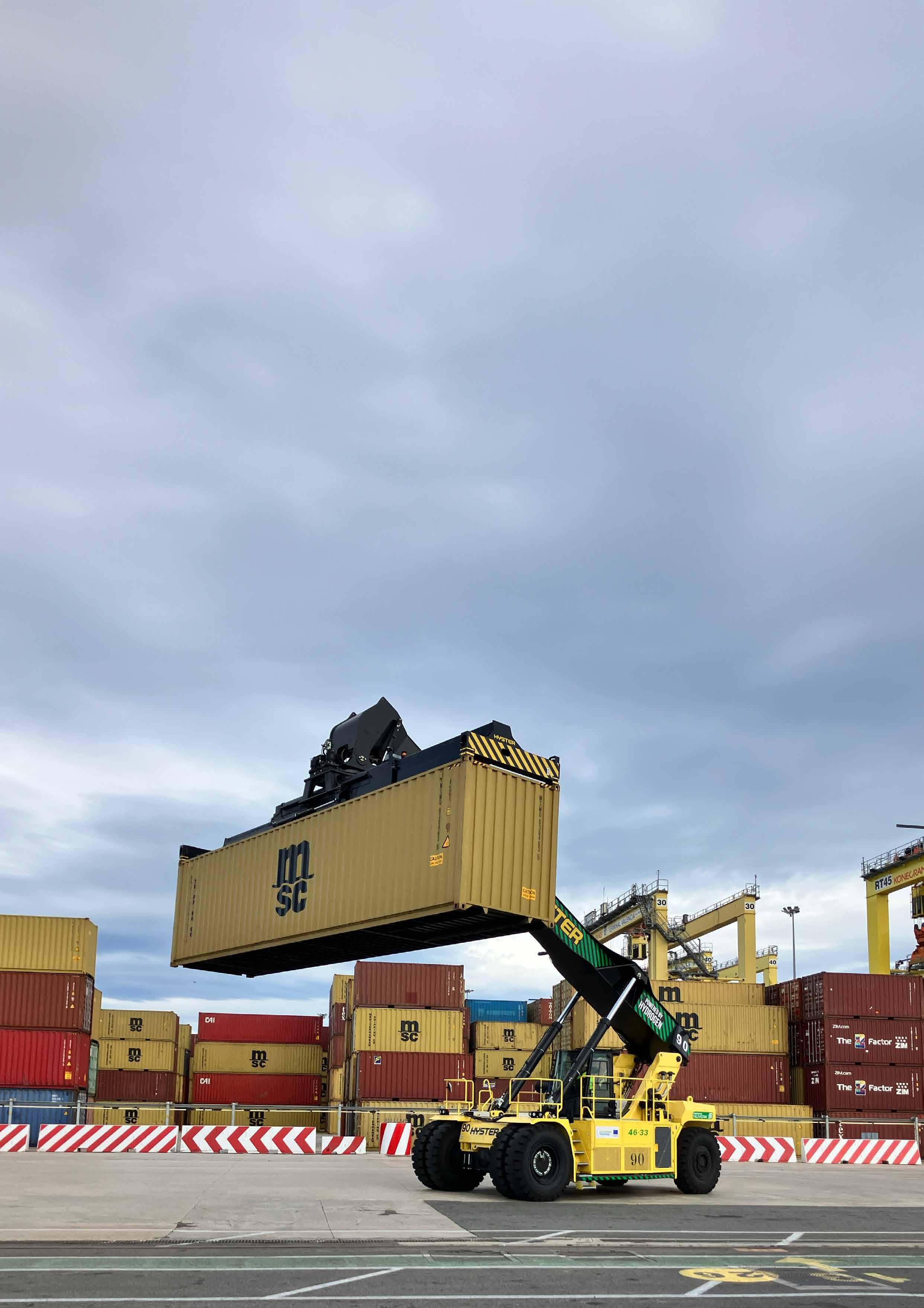
BELOW
A hydrogen fuel cell-powered ReachStacker currently being piloted at the Port of Valencia.
refuelling equipment, along utility grid changes or the production and transportation of hydrogen fuel. Looking beyond ports specifically to broader regulatory trends in the US for over-the-road vehicles, 11 states and the District of Columbia have passed or are considering some form of California’s mandate for manufacturers to sell zeroemission vehicles, according to the State of Sustainable Fleets 2024 Market Brief.
“LOOKING BEYOND PORTS SPECIFICALLY TO BROADER REGULATORY TRENDS IN THE US FOR OVER-THE-ROAD VEHICLES, 11 STATES AND THE DISTRICT OF COLUMBIA HAVE PASSED OR ARE CONSIDERING SOME FORM OF

2. HOW CAN I START TO GET A BETTER UNDERSTANDING OF HOW CLEAN POWER CHOICES MIGHT WORK AT MY PORT?
Take this opportunity to gather information about the development and prospects of various power technologies and to test and iterate at a small scale before pursuing the adoption of entire electric fleets. For instance, terminals can pilot a single electric container handler or trial electric alternatives for some of their lower-capacity equipment before transitioning additional units. While most container terminals typically rely on only five heavy-duty forklifts for every 40 or so container handlers, this equipment can be a good starting point. That is because in some cases, electrification of this forklift equipment is more mature relative to container handling equipment with much higher capacities. In fact, more than 100 large forklifts are already authorised for rebates in the CARB Clean Off-Road Equipment (CORE)
catalogue, including forklifts with load capacities of 7,000 to 9,000 kilogrammes (kg) and even ones in the 10,000 to 18,000-kg range Supplying electric power, whether from the grid or hydrogen, is a responsibility that port authorities must anticipate, not only for the demands of a single truck but multiple units or even a full fleet. Neither electricity nor hydrogen are primary fuels, so understanding the complete carbon impact requires looking at the feedstocks from which they are produced. In 2022, 21.5 per cent of electricity was generated from renewable sources like wind, hydro, solar, biomass and geothermal – up from only about 12 per cent of utility-scale electricity generation in 1990. The share of hydrogen that is green is lower, but cleanhydrogen production has the highest amount of announced investments , including $8 billion allocated by the Bipartisan Infrastructure Law to create regional hydrogen hubs.
ABOVE
The world's first hydrogen fuel cellpowered top pick container handler works as part of its pilot programme at the Port of Los Angeles.
Zero-emission options are being designed to provide enough capacity to keep operations moving and avoid the need to stop in the middle of a shift to recharge, or in the case of hydrogen fuel cells, refuel. However, the required time and frequency of recharging or refuelling are very important considerations and highly variable based on the application requirements. An operation’s duty cycle, the charging strategy, battery size, charger size and charge rate of the truck all influence how quickly a battery-electric solution can be recharged and how long it can operate between charges. Powering equipment with HFCs can mitigate many of the questions or concerns about the ability of electric alternatives to stand up to demanding run times, as operators refuel a tank of hydrogen similar to the process for refuelling with diesel. For large equipment like container handlers, it can take as
little as 15 minutes to fill the empty tanks with hydrogen – providing enough energy for up to 10 hours of continuous run time. And while green hydrogen is not yet universally available, there is a growing number of locations where access to this energy source makes it a very viable solution. While recharging batteries and refuelling with hydrogen pose a new set of challenges compared to internal combustion engines (ICE), electric drivetrains have fewer moving parts and less complexity, which can reduce the downtime required for maintenance. Electric equipment, batteries and certain wearable components, like switches, require replacement over time, but many time-consuming maintenance tasks are eliminated, such as taking the head off a diesel engine and rebuilding it every 15,000 hours or so.
4. DO I HAVE THE NECESSARY EXPERTISE AND SUPPORT FROM A LOCAL DEALER TO NAVIGATE THE SHIFT?
As with other material handling equipment decisions, a strong relationship with a supportive dealer is very important. Working with the manufacturer, a dealer
should have the experience and expertise to help you assess various power technologies and provide a solution that helps meet your goals for emissions reduction and performance. Since dealers not only sell critical equipment but provide training, parts and service, it is important to verify that the dealer you choose to work with is well-capitalised and trained. While the operator controls for electric equipment are intentionally similar to those of diesel equipment, operators need to be trained on best practices for recharging or refuelling electric forklifts or container handlers. Not all electric equipment is high-voltage, but electric equipment that is high-voltage also requires special technician training and certification to adhere to safety standards and prevent electrical danger or injury when performing maintenance. Many terminals have high-voltage electric ship-to-shore cranes already, but technicians who are certified to service that equipment may not have the product training that is required for high-voltage forklifts or container handlers. When the equipment needs service, the resources and staffing of your dealer can be the difference between a rapid response or waiting three weeks
for a necessary part or technician availability. As your terminal looks toward adopting electric equipment in the future, prioritise the maintenance support of skilled technicians or training support for your in-house technicians. For more information on electrifying your fleet, talk to your local Hyster® dealer or contact an electrification expert
Herman is responsible for providing solutions that align the company’s technology and big truck solutions with the needs of high-intensity operations, including electrification options for port terminals. He brings over 40 years of experience to his role and has a bachelor’s degree in mechanical engineering from the University of Illinois.
Hyster is a leading lift truck designer and manufacturer offering over 130 models with one of the widest capacity and power ranges in the industry. Supported by one of the industry’s largest and most experienced dealer networks, Hyster trucks offer high productivity, low cost of ownership and easy serviceability to customers globally.
“SUPPLYING ELECTRIC POWER, WHETHER FROM THE GRID OR HYDROGEN, IS A RESPONSIBILITY THAT PORT AUTHORITIES MUST ANTICIPATE, NOT ONLY FOR THE DEMANDS OF A SINGLE TRUCK BUT MULTIPLE UNITS OR EVEN A FULL FLEET.”



5G/
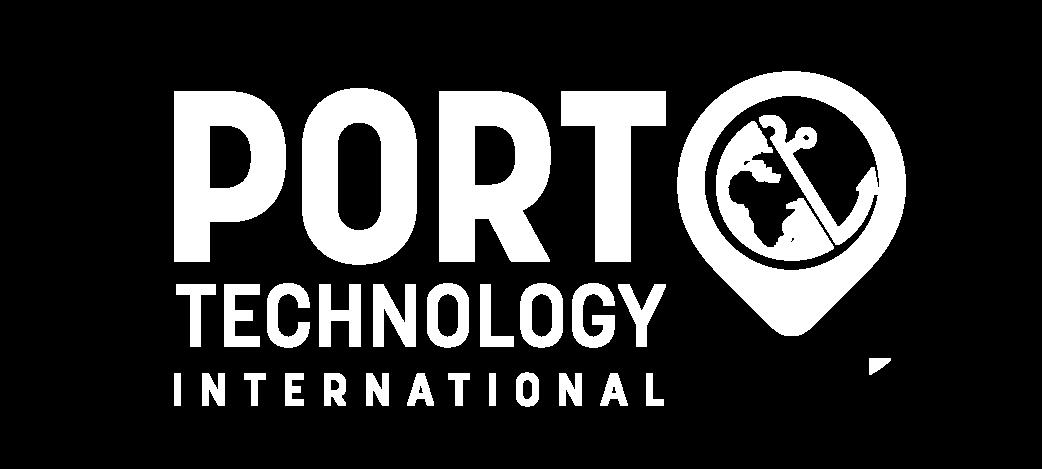

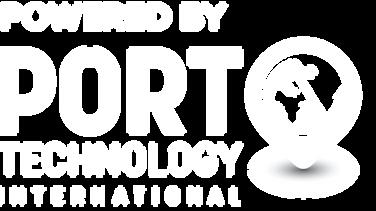
Presenting the first ever Port Technology Summit is coming to the Hilton Main in Norfolk, Virginia on 19 – 21 November following the successful Container Terminal Automation Conference North America 2024
We are excited to announce that the event will unite the ports industry, combining the best of our Smart Digital Ports and CTAC events into one annual flagship North American summit.
Visit the website to learn how you can take part!

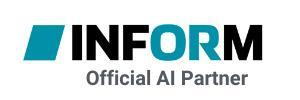

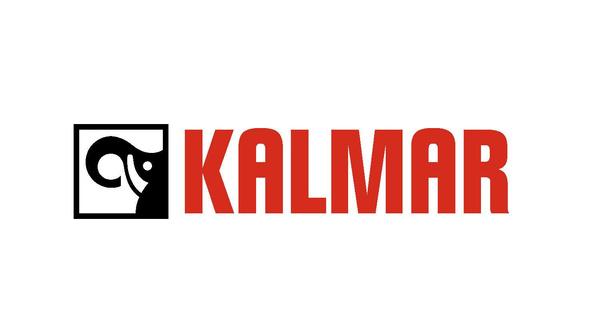













Panos Koutsourakis, VP Global Sustainability, American Bureau of Shipping (ABS)
While the maritime industry has focused squarely on emissions from ocean-going vessels relatively less attention has been given to port emissions. These emissions are difficult to measure, in part because ports’ emissions come from sources outside of direct control of the port, including vessels, rail and trucks.
Due to their strategic location at the interface between land and sea, ports play a crucial role in the integration of global supply chains by ensuring seamless connection to international markets. More than ever before, ports are expanding their attention beyond logistics and into mitigation strategies.
A new report aims to provide a concise and insightful update on the port decarbonisation landscape . It considers trends and lessons learned that will help ports, terminal operators, vessel operators, community stakeholders, policymakers and others work together toward maritime decarbonisation targets.
A unique collaboration between the American Association of Port Authorities (AAPA) and the American Bureau of Shipping (ABS) provides an opportunity to blend perspectives from practitioners in both port authorities and vessel operations.

An advisory group of 15, including AAPA members, ABS personnel and industry, was formed to support the project in reviewing the survey questions, draft and final report.
A central goal of the report was to provide a snapshot of current trends and near-term goals. While much work has been and needs to be done on long-term plans and strategies for port decarbonisation, this report is focused on the here and now. What is working, what is not and what can the maritime industry learn from projects and planning efforts currently underway at America’s ports?
The survey uncovered broad challenges in the port decarbonisation landscape. In
particular, transmission lines and charging infrastructure are being built at too slow a pace. Public funding is far too low to achieve advocates’ and ports’ decarbonisation goals. Technologies are not yet developed enough to allow one-for-one replacement of traditionally powered equipment.
In both written responses and interviews, this report also uncovered tremendous opportunities in the port decarbonisation landscape. Even with the absence of strict regulation, ports are finding ways to work with their public and private stakeholders to build out new decarbonisation projects.
New models of electric, hydrogen, biofuel and other alternativelypowered equipment are being deployed across the country. Through these deployments, ports are moving cargo and passengers, powering vessels and mitigating emissions. Not only are these projects supporting the American economy and having positive environmental impacts, but they are also working out the kinks in new classes of equipment that have never been used before. With each new generation of equipment, manufacturers are improving energy efficiency, horsepower, range and more.
Ports’ private terminal operator partners are working tirelessly to procure and implement these technologies, and the public sector
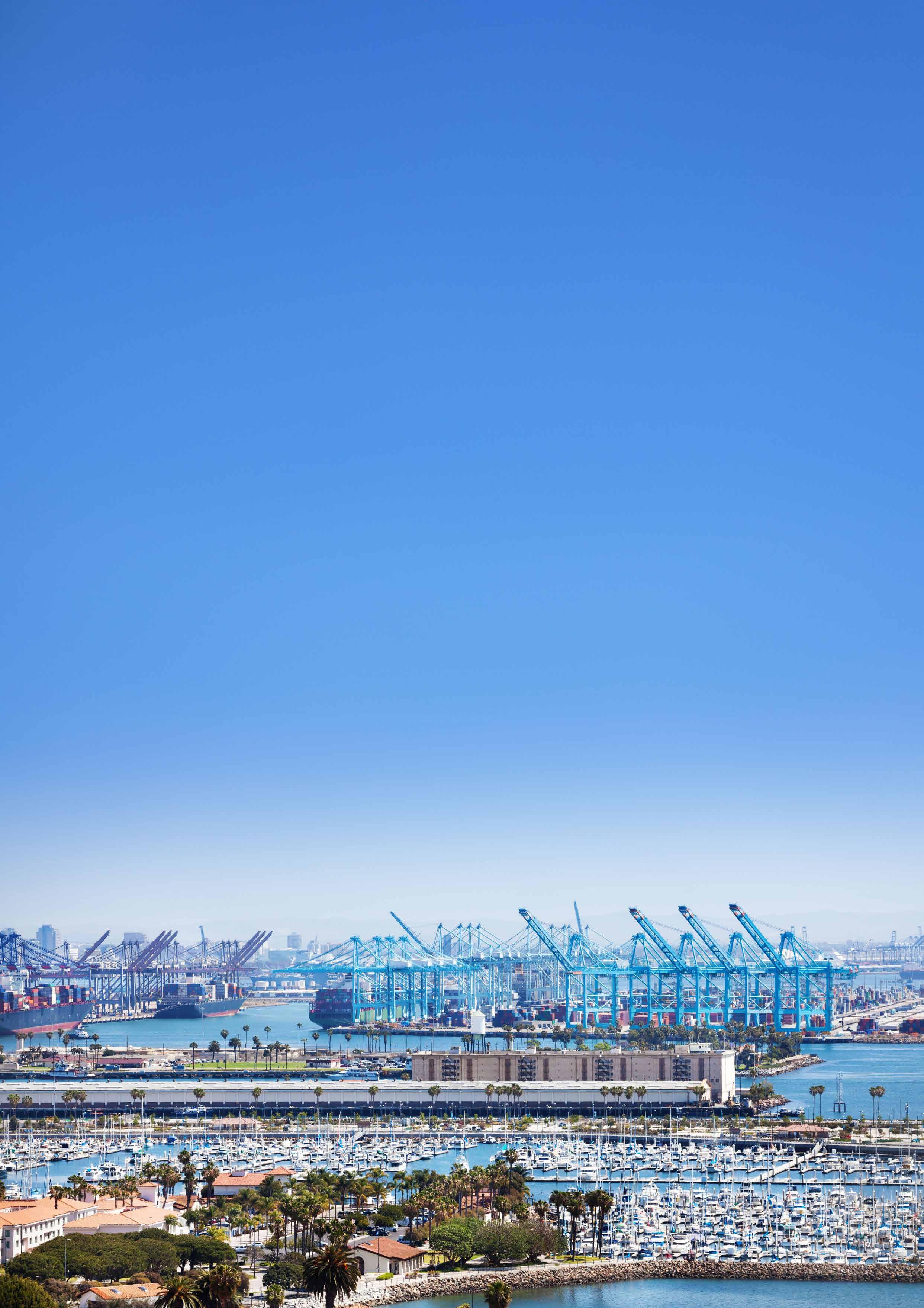
has made so much of this progress possible by making billions of dollars in funding available. The public sector also has a regulatory role to play, and our survey reveals that the federal and state governments should approach heavy-handed regulation with caution.
There are currently no federal government regulations specifically requiring port decarbonisation. As a result, the landscape across the port industry is uneven, with decarbonisation progress at specific ports largely driven by state and local regulation, customer demand and community pressure. Action is often taken at the local level, with local governments with jurisdiction over port authorities
setting decarbonisation goals. Perhaps the most prominent example is the South Coast Air Quality Management District (SCAQMD), which has jurisdiction over air emissions in several Southern California counties. SCAQMD has proposed an indirect source rule (ISR), which would require the Ports of Los Angeles and Long Beach to mitigate criteria pollutants significantly.
The California Air Resources Board (CARB) has also set several emissions standards to require vessels to connect to shore power at berth, require harbour craft to mitigate emissions, and require the trucking industry to shift towards zero emissions. While technologies and programmes to mitigate criteria pollutants and GHG differ, the result is often the same: implementation of zero-
“THERE ARE CURRENTLY NO FEDERAL GOVERNMENT REGULATIONS SPECIFICALLY REQUIRING PORT DECARBONISATION. AS A RESULT, THE LANDSCAPE ACROSS THE PORT INDUSTRY IS UNEVEN.”
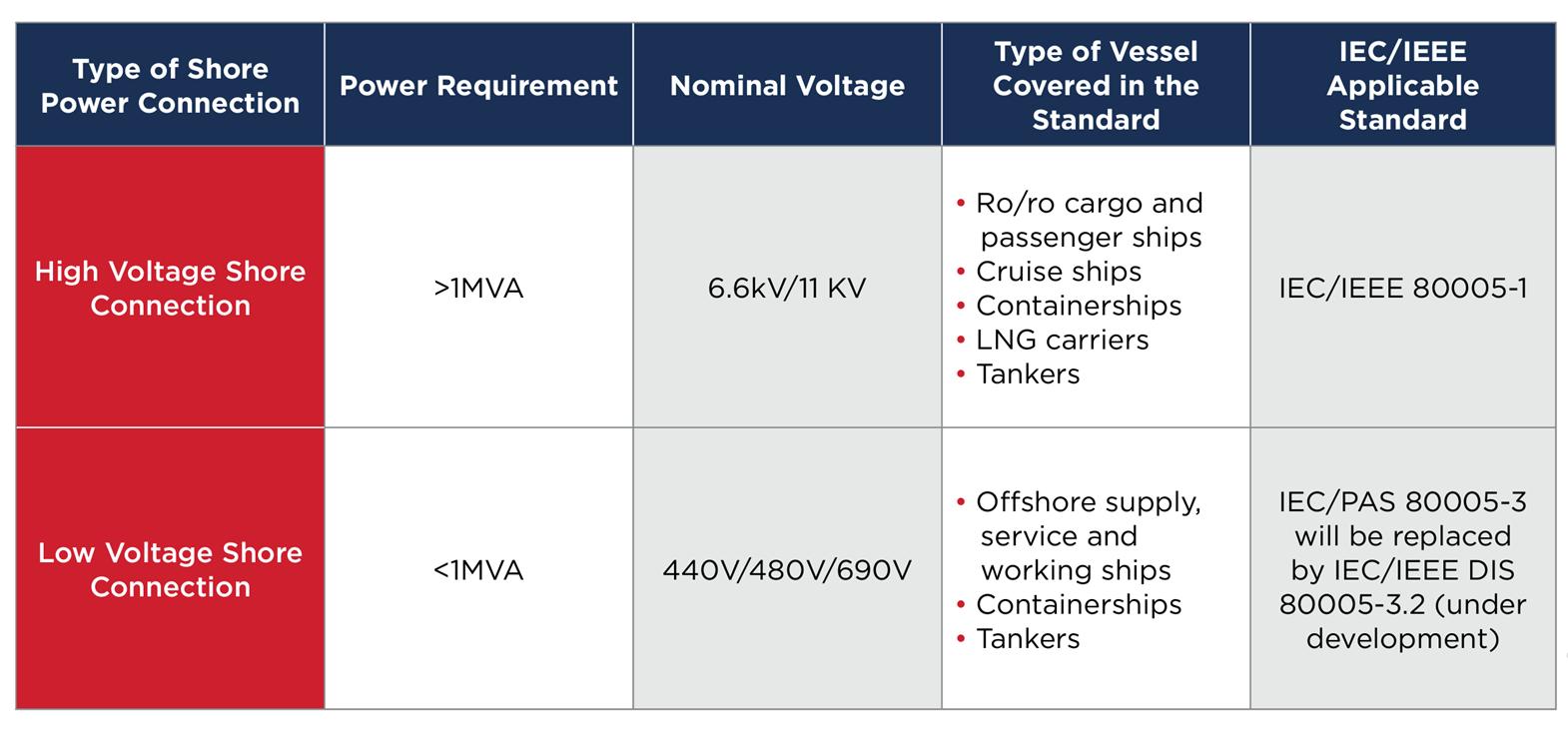
“STANDARDISATION OF SHORE POWER REQUIREMENTS FOR MANY TYPES OF VESSELS WITH LOW VOLTAGE AND HIGH VOLTAGE SYSTEMS IS STILL IN PROGRESS AND A CHALLENGE BROUGHT UP IN OUR SURVEY.”
emission equipment. However, hybrid equipment can in many cases reach decarbonisation and criteria pollutant mitigation goals in far shorter timelines than zeroemission equipment.
Cold Ironing, also known as Alternative Maritime Power (AMP), or more commonly shore power, consists of connecting vessels to shoreside power sources, thereby allowing electricity to flow from the port into ships.
Many ports are seeing a greater demand from vessel operators to support shore power connections. Considering the strong drive towards decarbonisation and the rise in fuel costs, this technology has been proven to bring financial and environmental benefits. The shore power emissions calculator developed by EPA is a good source to estimate the emissions mitigation potential of shore power systems.
Shore power connections found in US ports generally fall under types: high voltage systems (over 1kV, AC) and low voltage systems
(<1kV, AC). High voltage shore power systems support large vessels with high power demand such as cruise, containers, refrigerated vessels, etc. with 6.6kV or 11kV power systems. Low voltage shore power supports vessels with low voltage distribution systems between 220V and 480V and lower power demand such as fishing vessels, tugs, and offshore supply service and working ships.
Standardisation of shore power requirements for many types of vessels with low voltage and high voltage systems is still in progress and a challenge brought up in our survey question four. The need for standardisation of Direct Current (DC) shore power connection systems to support all-electric vessels is also rising steadily.
Figure 1 provides a summary of available standards for high-voltage and low-voltage shore connections. Shore power installations are very expensive and require upgrades to the port and grid infrastructure.
Public-private partnerships and government grants play a crucial role. According to ports in our interviews, shore power systems can cost $25 million per berth and
$1 million per vessel to be shore power compatible.
For ports with small budgets, infrequent calls from shore powercompatible ships, or frequent calls from bulk vessels, shore power systems may not be a costeffective investment.
It is crucial that ports involve the utility companies from the initial planning stage to ensure that shore power systems can be supplied without interruptions and the infrastructure is designed to consider future power demand. Design should also consider the use of mobile cable positioning devices to ease connection.
In practice, it is difficult for vessels to berth in the window of several feet that a stationary connection provides. Mobile positioning devices like a cable reel allow for connection along a wide range or the entire length of the berth.
LOCAL POWER GENERATION AND STORAGE
The survey results show that, while there is mixed interest, ports are investigating the installation of

local power generation. Per the survey results, local renewable power sources generally support less than 10 per cent of the total power needs of the port. Solar PV leads the list of ports’ preferred local energy sources. Building rooftops and canopies over parking spaces can provide space for solar power generation.
While ports play a pivotal role in the construction of offshore wind projects and the movement of onshore wind components, few seaports envision the installation of wind power on port property. However, studies have indicated that wind energy can be efficiently applied to meet the power demands of ports.
Many ports are also investigating fuel cells to support local power generation. By incorporating low/ zero-emission energy sources and battery storage systems, ports are building microgrids that can support the charging of electrical cargo handling equipment and vehicles and improve energy resilience.
The report also shows the need for future study. Among questions that this report did not address, but would be valuable to have answered include:
• How has the performance of low- and zero-emission equipment improved over time and in different conditions, including range, charging time and duty cycles?
• What is the total cost of ownership of various types of equipment, and can low- and zero-emission equipment save money over diesel in the long run?
• What is the economic benefit of port decarbonisation, including energy savings, cargo throughput and local health cost savings? Through further standardisation and economies of scale, can the cost of low- and zero-emission equipment be reduced?
• Can the cost of charging and fueling port equipment be brought down through greater efficiency in transmission infrastructure build-out?
• Would the availability of alternative fuels at American ports confer global economic competitiveness?
Above all, the report and the scope of questions it studied reveal the fast-developing and critical importance of port decarbonisation and the study of its progress. The port and maritime industries are advancing at a rate not seen perhaps since the advent of
containerisation. If one thing is clear, America’s port professionals are dedicating immeasurable hours and attention to port decarbonisation, and the future of this field contains immense opportunities for economic development, environmental protection, and global trade.
ABOUT THE AUTHOR:
Panos Koutsourakis is an 18year industry veteran who has key industry experience with shipping companies, classification, operations, design and new construction, decarbonisation technologies and strategic planning. As Vice President of Global Sustainability at ABS, Koutsourakis heads up a global network of sustainability centres in key maritime locations, including Singapore, Athens, Houston, Copenhagen and Shanghai. Koutsourakis holds an MEng in Naval Architecture and Marine Engineering from the National Technical University of Athens.
ABOUT THE ORGANISATION:
ABS is defined by a vision, a mission, and a core set of traits that make us truly unique. As important today as they were in the past, these characteristics define how we approach our work. Together, they describe the Spirit of ABS. Founded in 1862, ABS is a global leader in providing classification services for marine and offshore assets. Our mission is to serve the public interest as well as the needs of our members and clients by promoting the security of life and property and preserving the natural environment. ABS’ commitment to safety, reliability and efficiency is ever-present.
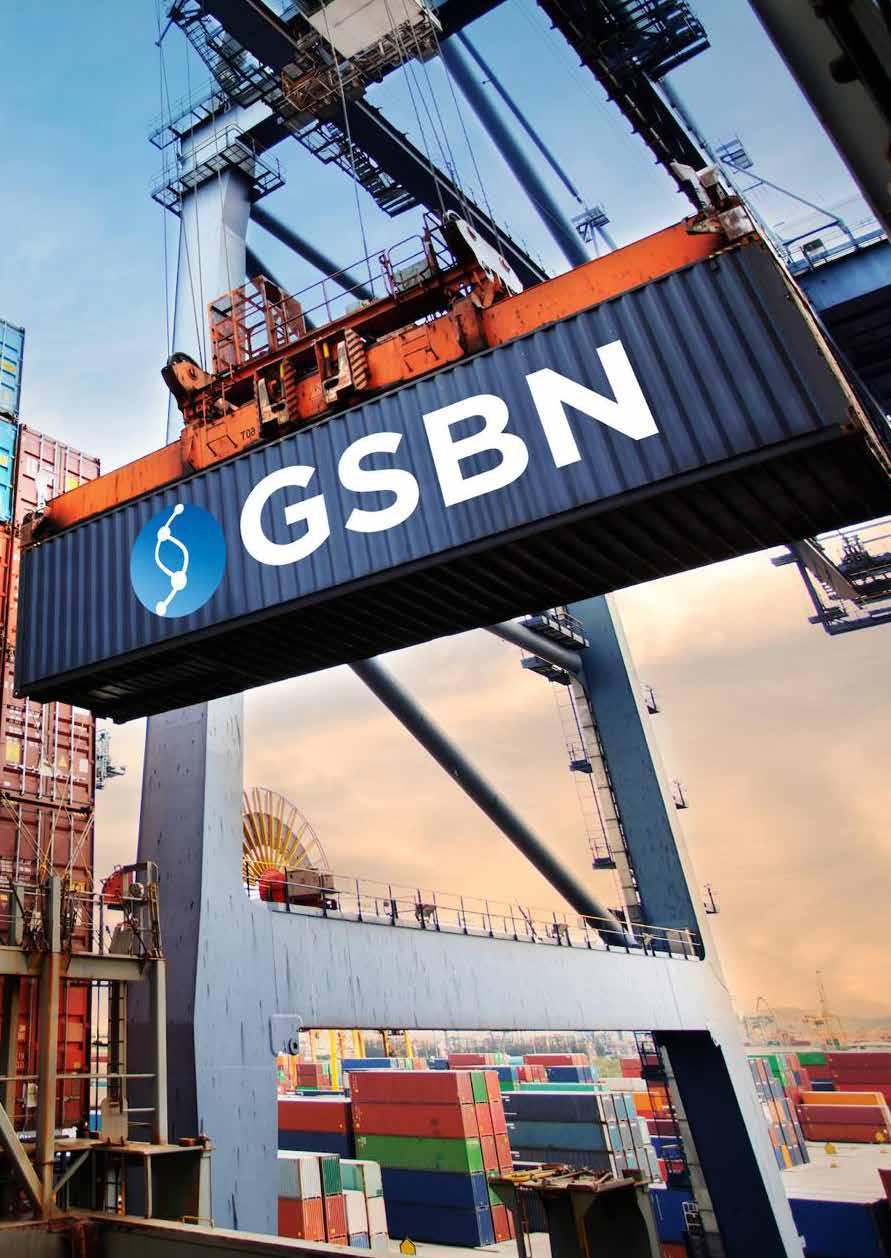


One of the most profound advancements in the shipping industry is the shift from the paper-based Bill of Lading to the electronic Bill of Lading (eBL). This transition cannot be stopped. Milestones driving this momentum include the FIT Alliance's commitment to eBLs by 2030 and wider adoption of the Model Law on Electronic Transferable Records (MLETR) by the UK and France, reducing barriers to eBL adoption. This is significant for two reasons. First, the shift is being underpinned by a major transformation of data infrastructure through blockchainenabled platforms that allow secure sharing of trusted shipping data across complex supply chains. It's not merely about replacing paper documents with digital equivalents but about embedding trusted data directly into reimagined workflows. Second, for the first time, each physical shipment has now a oneto-one digital representation, which can enable further secure sharing of rich data tied to each shipment.
While this can unlock farreaching benefits from greater efficiency to trade finance, it is also paving the way to support the industry’s steps towards decarbonisation. For starters, a study by SIA Partners commissioned by the Global Shipping and Business Network

(GSBN) estimates the transition of the circa 16 million paper bills issued annually could reduce CO2e emissions by up to 440,820 metric tonnes. As a point of reference, the annual emissions for the country of Andorra are 470,000 metric tonnes. Although significant, the fundamental impact of digitalisation in the industry’s decarbonisation transition goes far beyond this. NVIDIA's CUDA revolutionised high-performance computing by providing an abstraction layer for a large group of developers to harness the power of GPUs for a wide range of applications, most notably Artificial Intelligence (AI). Similarly, the eBL is leading shipping towards a similar transformative future by making it easier to query the
carbon footprint of each shipment and to share the relevant data with proper control.
The European Union (EU) is at the forefront of maritime decarbonisation efforts, having implemented stringent regulations with more on the horizon. The International Maritime Organization (IMO) has also made commitments to reach net-zero carbon emissions by 2050.
One of the primary avenues for achieving decarbonisation is the adoption of alternative fuels. Green fuels such as e-methanol or e-ammonia are essential for reducing emissions
“THE EBL IS LEADING SHIPPING TOWARDS A TRANSFORMATIVE FUTURE BY MAKING IT EASIER TO QUERY THE CARBON FOOTPRINT OF EACH SHIPMENT AND TO SHARE THE
in the shipping sector. China, with its capacity, resources, and supportive policies, is leading the charge in producing these alternative fuels at scale. Maersk has already signed offtake agreements with leading Chinese green utility providers such as Goldwind to secure green fuel supplies for their fleet of dualfuel ships, setting a precedent for others to follow.
Yet a major challenge remains the price of those alternative fuels, often a high multiple of traditional fuels. At the 81st session of the IMO’s Marine Environment Protection Committee, the top of the agenda was exploring the
pricing mechanism for greenhouse gas (GHG) emissions. During the session, a proposal from the World Shipping Council (WSC) suggested a Green Balance Mechanism to close the price gap between fossil and green fuels. This includes levying fees on fossil fuels and allocating them to green fuels to equalise their costs. Additionally, the proposal suggests a mechanism whereby the greater the reduction in GHG emission achieved by a fuel, the larger the financial allocation it receives. However, to ensure the effectiveness of pricing models and mechanisms, transparency and accuracy of green claims are required.

BELOW
Green fuels such as e-methanol or e-ammonia are essential for reducing emissions in the shipping sector.
REIMAGINING THE GREEN CERTIFICATES AND TRUST MECHANISM
Several carriers have launched green shipping products, including Maersk's Eco Delivery, HapagLloyd's Ship Green, Ocean Network Express (ONE)'s LEAF+, CMA CGM's ACT+, and COSCO's Hi-ECO, which involves GSBN.
Green certificates from such products offer a means for customers to contribute to decarbonisation efforts by purchasing green claims as well as provide demand signals to drive investment in green shipping. Yet for these certificates to be credible
“GREEN CERTIFICATES OFFER A MEANS FOR CUSTOMERS TO CONTRIBUTE TO DECARBONISATION EFFORTS BY PURCHASING GREEN CLAIMS AS WELL AS PROVIDE DEMAND SIGNALS TO DRIVE INVESTMENT IN GREEN SHIPPING.”
and verifiable, they must be linked to tangible activities, such as the purchase and usage of green fuels.
The current approach has several shortcomings. Currently, the methodology for accounting for emissions is based on frameworks endorsed by organisations such as Smart Freight Center with their Clean Cargo Program, and green fuels are verified by organisations such as the International Sustainability and Carbon Certification (ISCC). Under this system, the carrier would calculate and issue its green certificates according to the established methodology. The process itself might be audited from time to time by an auditor.
This means actual certificates and associated green claims are never directly issued against actual shipments or purchases of biofuel data. A customer will never have access to the underlying data and will have to rely on carriers and their auditors. However, the introduction of new blockchainenabled infrastructure and eBLs, serving as a digital representation of any single shipment, is creating a better process.
COSCO’s Hi-ECO product, for example, harnesses GSBN’s neutral blockchain platform to establish a linkage between the Proof of Sustainability (PoS) Certificate, which documents the actual purchase of biofuel by the carrier, and green certificates issued to customers. Trusted parties throughout the process – from
biofuel providers to verifiers such as DNV – can provide verified data about a particular shipment over the blockchain, enabling easy verification through attestation. This connection guarantees that each certificate corresponds to an actual purchase of biofuel and, by linking with an eBL, it provides direct, traceable green claims against every physical shipment. This ultimately enhances credibility and establishes a foundation of trust among all participants involved in the shipping process.
In the move towards digitalisation and decarbonisation, different parties across the supply chain will play an evolved role. Each will need to use trusted data to play their part. While different parties will have their own approaches and interfaces, they will connect and collaborate via neutral, agnostic infrastructure such as blockchainenabled GSBN.
Just as NVIDIA’s CUDA paved the way for GPUs to transform gaming and now AI technology, eBLs serve as crucial building blocks to enable new value creation and the transition towards a sustainable future. Those who are quick to recognise this context and embrace the transition can build a competitive advantage by achieving greater optimisation and creating new solutions to ultimately get ahead.
ABOUT THE AUTHOR:
Bertrand Chen is the CEO of Global Shipping Business Network (GSBN), an independent, notfor-profit consortium enabling paperless, accessible and sustainable global trade. Bertrand oversees the consortium’s overall strategy, with a mandate to serve the best interests of the industry at large and is not influenced by any agenda and tradition.
ABOUT
The Global Shipping Business Network (GSBN) is a neutral, not-for-profit consortium whose mission is to enable paperless, accessible and sustainable growth in global trade with its data infrastructure and ecosystem of partners. GSBN facilitates trusted collaboration between participants across the shipping industry to enable greater efficiencies, and paperless trade as well as supporting the shipping industry’s decarbonisation transition. GSBN’s ecosystem includes shipping lines, terminals, banks, application developers and other consortia. The entire network accounts for more than half of the containers handled in the world.
www.gsbn.trade
“IN THE MOVE TOWARDS DIGITALISATION AND DECARBONISATION, DIFFERENT PARTIES ACROSS THE SUPPLY CHAIN WILL PLAY AN EVOLVED ROLE. EACH WILL NEED TO USE TRUSTED DATA TO PLAY THEIR PART.”



Wolfgang Lehmacher, Supply Chain and Technology Strategist, with Mikael Lind, Senior Strategic Research Advisor, RISE, and (Adjunct) Professor in Maritime Informatics, Chalmers
Over recent years, the logistics industry has been moving towards digitalisation. This development has been motivated by the expectation of lower costs, fewer delays, a better grip on inventories and goods in transit, but also lower GHG emissions and more accurate GHG emissions calculations. Digitalisation also means taking paper out of the process. Electronic documents are considered more sustainable than paper documents as they reduce the use of physical resources and minimise waste. According to Global Efficiency Intelligence, the pulp and paper industry is the fourth largest industrial energy user and accounts for approximately 2 per cent of direct industrial carbon dioxide emissions. But turning paper into bytes remains a challenge.
In a self-organising system like logistics, every stakeholder—such as carriers, terminals, forwarders, and government agencies—is required to ensure that their procedures, processes, and systems are ready to process and transfer digital documents. Laws and regulations should be harmonised across borders and modes.
Several digitalisation initiatives have been launched across the world and all modes of transport.
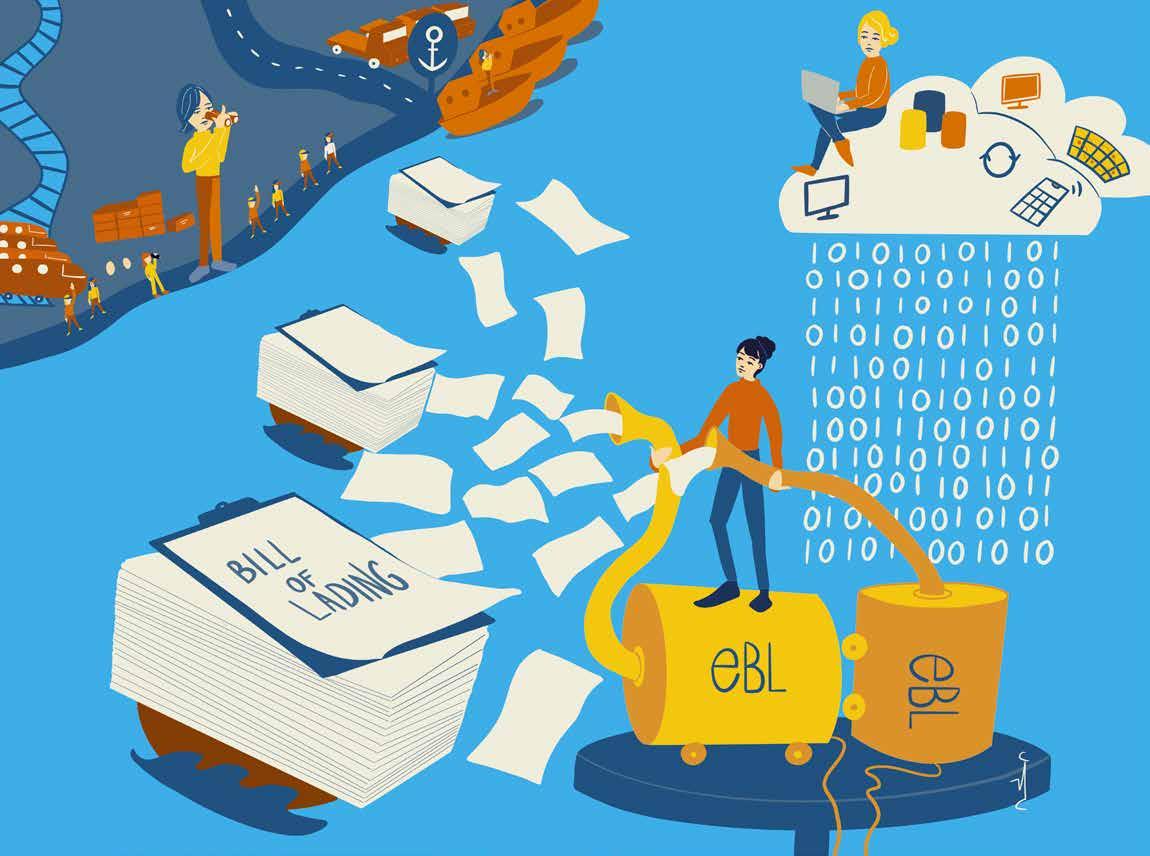
The various developments have reached different stages of development. We consider aviation the most advanced industry in electronic document implementation, a benchmark and example to study.
The digitalisation of transport documents has been a long shot. In shipping, an early attempt was the Bill of Lading Electronic Registry Organization (Bolero) which was commercially launched in 1999. The vehicle of the EUfunded initiative was Bolero International Ltd., a joint venture
between the Society for Worldwide Interbank Financial Transactions (SWIFT) and the Through Transport Mutual Insurance Association Ltd. (TT Club). In 2021, shipping lines MSC, Hapag Lloyd, and ONE introduced the electronic bill of lading (eBL) in their operations. The IATA’s e-Freight initiative for air cargo was launched in 2005. In road freight, the Additional Protocol concerning the electronic consignment note (e-CMR) was added to the convention in 2008, which entered into force in 2011. This article

“DIGITALISATION IS FIRST A MATTER OF MINDSET. THE FOUNDATION FOR IMPLEMENTATION IS THE BROAD ACCEPTANCE BY INVOLVED STAKEHOLDERS OF THE USE OF ELECTRONIC DOCUMENTS.”
investigates various experiences in implementing electronic documents and elaborates on what is needed to accelerate the implementation across the globe and all modes of transport.
In air freight, the e-AWB has become the standard and default contract of carriage for air cargo shipments on enabled lanes since 1 January 2019. Over 85 per cent of all air cargo transport is now using e-AWBs and IATA has set the goal of reaching 100 per cent e-AWB adoption by 2026.
In road freight, the e-CMR protocol has been ratified by 35 countries and several additional countries are working on the ratification.
In 2021, MSC and then both Hapag-Lloyd and ONE made a big step and introduced the eBL in their operations. These and additional carriers that have followed them are striving now
to reach 100 per cent adoption of digital documents in ocean freight to reduce cost and gain time. Digital documents can be created and distributed in minutes, errors can be reduced, and they can be tracked in real-time, sparing paper and emissions. This explains why the implementation of the e-BL is high on the agenda of the DCSA and BIMCO. In 2023, BIMCO launched its “25 by 25 pledge” where bulk shippers commit to moving 25 per cent of their annual seaborne trade for at least one commodity on eBLs by 2025. Supporters of the initiative are American, BHP, Rio Tinto, and Vale.
Although we have long entered the digital age many stakeholders, including authorities and courts , don’t accept documents in digital form. Regularly, people in the process raise their hands asking for a paper document.
Regulatory fragmentation is a major hurdle. Varying requirements across jurisdictions, government agencies, and transport modes make adoption complex. Many jurisdictions do not recognise digital documents, in particular, negotiable instruments like the electronic bill of lading as equivalent to paper documents. Some laws place ill-defined criteria, like the United Kingdom Electronic Trade Documents Act which requires “reliable systems” but does not well define the criteria for reliability. The need for “exclusive control”, requested by legal frameworks, e.g., the Rotterdam Rules, which allows e-documents to function as documents of title is technically difficult to implement. The need for ancillary agreements like additional service agreements adds complexity. Data inconsistencies hinder the digital data flow. Digitalisation of supply chains requires that actors can rely on common formats and harmonisation of the data shared between consignors, carriers, and consignees when goods are handed over from party to party. Limitations of decades-old legacy systems and internal fragmentation are additional hurdles. Actors still struggle to integrate their processes due to limits imposed by the systems they operate. Many legacy systems cannot efficiently process, store, and transmit e-documents. Some struggle to scale with the growing volume of data and legacy systems are expensive to maintain which can make the introduction of digital documents prohibitive. Issues concerning interoperability, integration, and compatibility can be added to the list of challenges.
Digitalisation is first a matter of mindset. The foundation for implementation is the broad acceptance by involved stakeholders of the use of electronic documents. Informing and educating all stakeholders about the benefits of digital trade
and transport is a critical factor in accelerating the implementation and adoption of electronic documents. What did IATA do to successfully implement the e-AWB?
IATA took a strong lead in the development and implementation of the e-AWB by developing industry standards, creating the multilateral e-AWB Agreement that once signed with IATA allowed airlines and freight forwarders to use the e-AWB with all other parties to the agreement, publishing an implementation playbook as a step-by-step guide and launching the e-AWBLink, a low-cost desktop portal to help smaller freight forwarders adapt,

and offering guidance and tools to facilitate adoption, like technical readiness assessments, training, workshops, and conferences. Governments’ adoption and filing of IATA Recommended Practice 1670 provided the necessary regulatory support and framework for e-AWB implementation. Provided the e-AWB is used as an e-CSD (Consignment Security Declaration), an example of harmonisation is the European Union (EU) eFTI regulation of July 2020 which introduces uniform conditions for sharing electronic freight documents with competent authorities. An eFTI data set, defined by the eFTI regulation, is not an
electronic freight document. However, it supports a uniform, secure and reliable mechanism to share most of the information present in the consignment note (information present in the transport document) for road, rail and inland waterways. The goal of sharing this information is for administrative control purposes, and only authorised competent authorities can access it. As such, eFTI does not cover the acceptance of the validity of the electronic form of the transport contract.
It is critical now to replace or turbocharge prohibitive legacy systems to ensure that they can handle e-documents efficiently and cost-effectively. This challenge
“THE TIME HAS COME TO TIE ALL PIECES TOGETHER AND THINK ABOUT A GLOBAL TRANSPORT E-DOCUMENTS INITIATIVE ACROSS BORDERS, MODES, AND JURISDICTIONS.”
is significantly amplified when they also serve as contractual documents. Validity in courts is a primary issue. Companies must invest in appropriate systems and training for the workforce to be able to shift from paper to electronic documents and processing.
What are the important next steps? Harmonised international rules and national laws on multimodal transport will drive efficiencies and create confidence in e-documents and legal certainty. Harmonised electronic documents recognised across borders and modes would streamline processes. Also, a digital documentation process requires the recognition of qualified electronic signatures. Acceptance of electronic documents by authorities and courts across the globe would be a breakthrough. The Global Legal Entity Identifier Foundation (GLEIF) has been established to enable company verification and authentication by providing a global register where buyers, sellers, financiers, and other actors can see who the parties they dealing with are and whether those are verified and legitimate.
The time has come to tie all pieces together and think about a global transport e-documents initiative across borders, modes, and jurisdictions.
The supply chain industry seems ready to move forward towards digital documents. However, disparities and fragmentation in all kinds and forms are the hurdles to the implementation and
adoption of digital documents in transport and trade. The focus is on converting paperwork into digital documents, which means PDF files. However, the real digitalisation of documents comes with converting them into datasets as a prerequisite for seamless supply chain digitalisation.
Considering the well-documented advantages and benefits of supply chain digitalisation, such as reduced costs, errors, and GHG emissions, this article calls for the launch of an international multi-stakeholder collaboration initiative across all modes of transport to accelerate the adoption of digital documents in transport. Such a collaborative breakthrough effort requires private-public partnerships, crossgovernmental collaboration on the acceptance of electronic documents, as well as regulatory alignment across jurisdictions. In parallel, impeding legacy systems must be replaced or turbocharged, AI supports the latter. Such an initiative would underline that digitalisation of transport is a priority.
Why is such a cross-industry initiative needed? Industry associations and projects are very important drivers of progress. But considering the enormous global challenges that the economy and society are facing, it’s time to strengthen and align the different parts of the global coordination layer. The one-million-dollar question is which independent organisation can take the strong lead to make the digitalisation of documents happen and create economic, symbolic, and environmental capital. Realising the ambition requires that candidates have the proper governance, credibility, and subject matter resources.
We want to especially thank Thomas Bagge, Digital Container Shipping Association (DCSA), and Rudy Hemeleers, 51Biz Luxemburg, for their input to this article.
ABOUT THE AUTHORS:
Wolfgang Lehmacher is a partner at Anchor Group and an advisor at Topan AG. Former Director at the World Economic Forum, and CEO Emeritus of GeoPost Intercontinental, he is an advisory board member of The Logistics and Supply Chain Management Society, ambassador F&L, and advisor to GlobalSF and RISE.
Mikael Lind is the world’s first (adjunct) Professor of Maritime Informatics engaged at Chalmers and Research Institutes of Sweden (RISE). He is a well-known expert, and his work is regularly published in the international trade press. He is co-editor of the first two books on Maritime Informatics , and the book Maritime Decarbonization



Nora von Xylander, Biodiversity Specialist & Sustainability Scientist, Tunley Environmental
Considering the global initiatives to become nature-positive by 20301 and the United Nations (UN) Sustainable Development Goals2 , the concepts of Biodiversity Net Gain (BNG)3 and Marine Net Gain (MNG) are gaining traction4,5. Here we explore the potential of marine restoration in contributing to MNG, carbon sequestration, and port decarbonisation, addressing the critical need for effective marine restoration strategies in the face of climate change, marine pollution, and overfishing6,7,8
We find that the positive impacts of restoration and reviving marine habitats are wide-ranging, from enhancing biodiversity and supporting sustainable fisheries9, and improving water quality10, to contributing to carbon offsetting efforts11. All helping to combat climate change, mitigate its effects on our planet, and secure a more sustainable future.
The ocean, covering 71 per cent of the Earth's surface, is home to approximately 80 per cent of
“MARINE

all life on Earth12 . Healthy marine ecosystems generate 50 per cent of the oxygen that we breathe and absorb 25 per cent of all CO2 emissions13. The ocean and its marine habitats also play a crucial role in regulating the Earth's climate by absorbing up to 90 per cent of the additional heat generated from anthropogenic CO2 emissions13 Accordingly, marine restoration holds immense importance in safeguarding the health and vitality of our oceans9
As human activities continue to take a toll on marine ecosystems14,15, restoration efforts offer a glimmer of hope. A wide range of methods and techniques are employed in marine restoration projects, depending on the specific ecosystem and the restoration goals (see Figure 1). By restoring damaged habitats, such as coral reefs, seagrass beds, and mangrove forests, we can create resilient ecosystems that can withstand the impacts of climate

change and support a diverse array of marine life16.
On top of being crucial for marine biodiversity, these restoration efforts can provide shoreline protection17, carbon sequestration11,18, and the provision of food and livelihoods for coastal communities. Several marine restoration projects have achieved remarkable success in recent years, showcasing the potential for positive outcomes and significant carbon sequestration potential19,20,21 In the US, oyster reef restoration in Chesapeake Bay has improved water quality and biodiversity22 These projects highlight the benefits of dedicated restoration efforts, which can act as catalysts for positive change and provide valuable insights for future projects.
Through restoring and protecting marine ecosystems, as well as engaging with local communities and stakeholders in marine restoration projects, we can raise awareness about the importance of ocean conservation and foster a sense of stewardship, all ensuring the long-term sustainability of these services, benefitting both the environment and human societies.
The Science Based Targets for Nature (SBTN) states that: “There is no net zero without meaningful action on Nature”23. Marine restoration efforts offer significant opportunities for integrating Marine Net Gain (MNG) and carbon offsetting to effectively address climate change.
MNG, a relatively new concept being discussed in the UK24 , aims to enhance marine habitats through development projects4,5, moving beyond traditional methods of merely minimising harm to the environment. Under the MNG approach, similar to biodiversity net gain (BNG), developers would be required to deliver measurable improvements to marine habitats to compensate for any loss to marine habitats that may occur due to their projects. This can be achieved through the restoration or creation of new habitats, as well as the implementation of measures to reduce impact and protect vulnerable species. By prioritising
MNG, marine development projects can contribute to the conservation and restoration of marine ecosystems, even in areas where habitat loss is unavoidable. This approach not only benefits the environment but also ensures the long-term sustainability of development activities by integrating environmental considerations into their planning and implementation.
Simultaneously, marine restoration and MNG efforts represent a significant opportunity for carbon offsetting. This approach allows individuals, organisations, or governments to compensate for their carbon emissions by investing in projects that reduce or remove GHG from the atmosphere. While mostly associated with land-based activities, such as reforestation and land-based renewable energy projects, marine habitats play a major role in carbon sequestration11,16. Healthy marine ecosystems have the capacity to sequester and store vast amounts of carbon. As such, there has been an exponential increase in marine restoration efforts9 and marine renewable energy projects25,26,27,
“ANTHROPOGENIC ACTIVITIES SUCH AS FISHING AND SHIPPING HAVE SIGNIFICANTLY IMPACTED MARINE HABITATS AROUND PORTS. DIRECT ENGAGEMENT
both playing a critical role in carbon offsetting.
Marine restoration projects can also indirectly contribute to carbon offsetting by reducing the need for destructive practices that release large amounts of carbon, such as bottom trawling or dredging28. By restoring and protecting these marine ecosystems, we can enhance their biodiversity and carbon storage potential. Thus, contribute to global efforts to help mitigate the biodiversity loss crisis29,30 and carbon emissions, both promoting a more sustainable future.
Anthropogenic activities such as fishing and shipping have significantly impacted marine habitats around ports31,32,33. Direct engagement with these industries offers an opportunity to alleviate environmental pressures and adopt sustainable practices, yielding extensive environmental benefits. As such, we explore the feasibility of restoring and reviving marine habitats within port locations
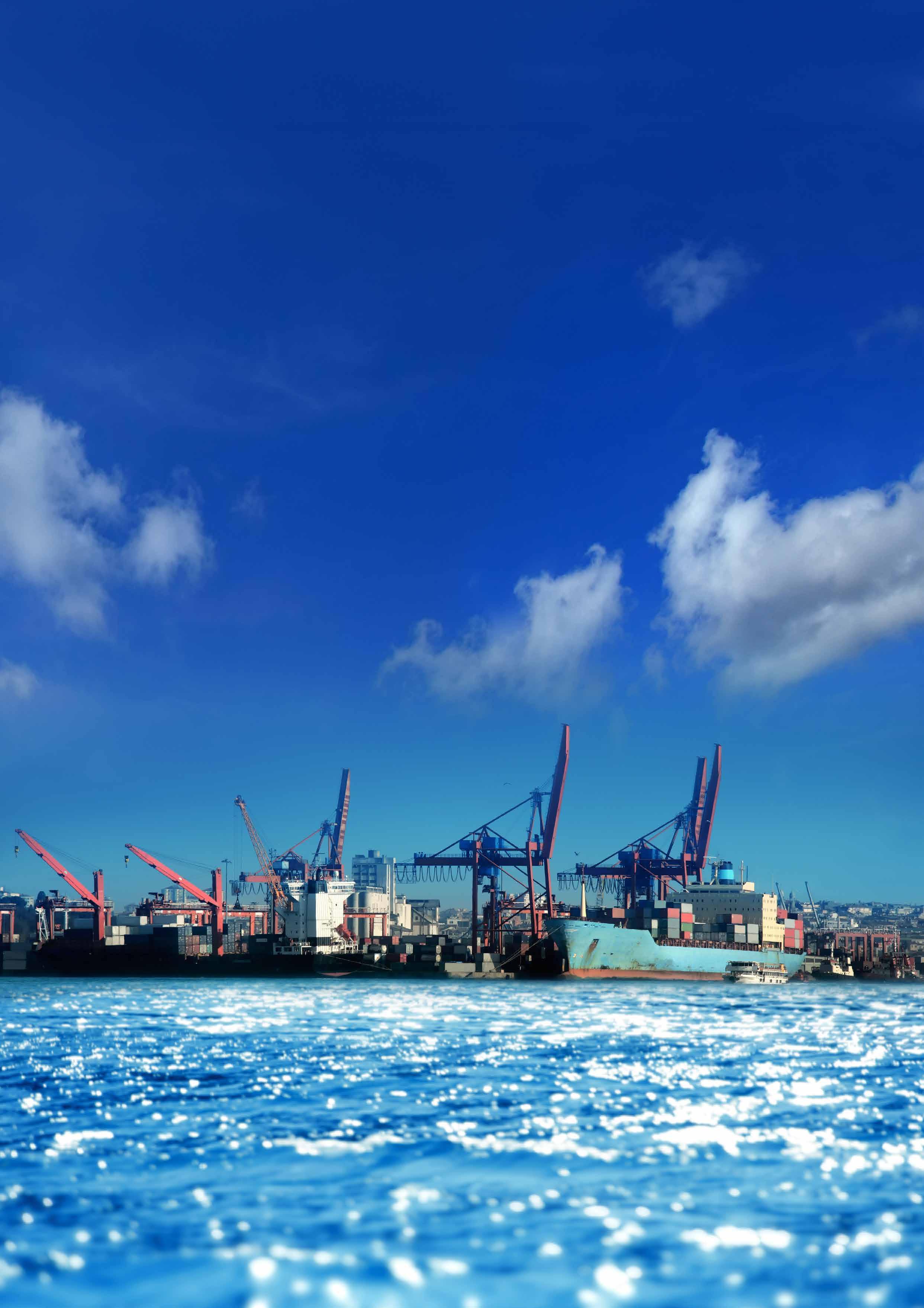
as these subsea habitats hold significant potential for both biodiversity conservation and carbon offsetting.
Targeted restoration efforts should be considered due to the typical impact of fishing and shipping activities on marine ecosystems, including habitat degradation and pollution. By revitalising subsea habitats, such as seagrass meadows (or coral reefs depending on location), we can create essential corridors that support a rich tapestry of marine life. The restored habitats act as natural buffers, enhancing
“BY INVESTING IN MARINE RESTORATION PROJECTS THAT INCORPORATE THE CONCEPTS OF MNG AND CARBON OFFSETTING AT PORT LOCATIONS, GOVERNMENTS, BUSINESSES, AND ORGANISATIONS CAN ENHANCE THEIR SOCIAL RESPONSIBILITY AND DEMONSTRATE THEIR COMMITMENT TO SUSTAINABLE PRACTICES.”
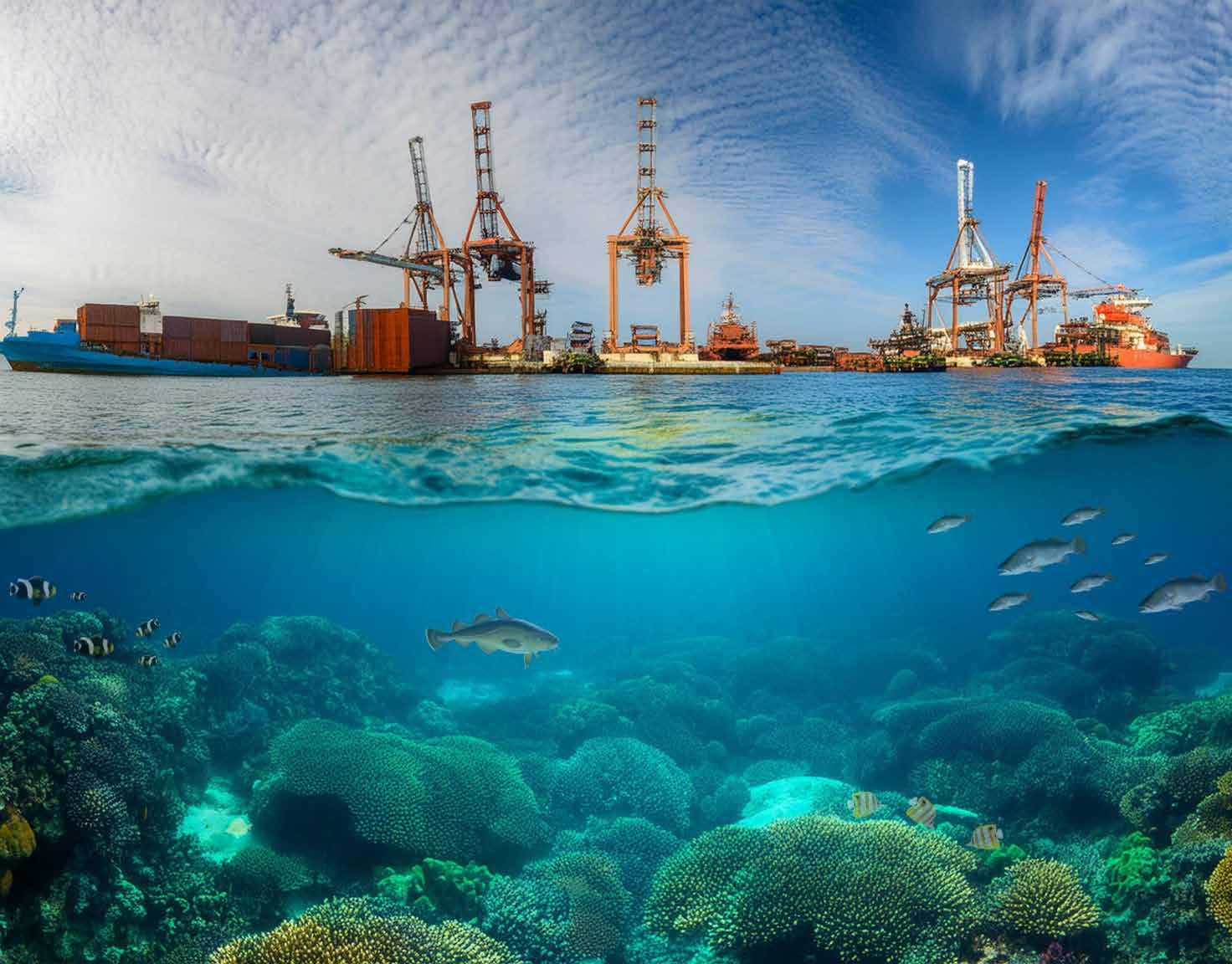
biodiversity by providing shelter, breeding grounds, and feeding areas for a myriad of species (Figure 2).
The revitalised ecosystems can also contribute to carbon offsetting, with the potential to sequester substantial amounts of carbon dioxide. It is crucial to integrate a variety of species suited to the specified habitat to maximise biodiversity gains, ecosystem resilience, and carbon offsetting potential.
Habitat restoration efforts often go hand in hand with the removal of invasive species and the implementation of stricter regulations to prevent further degradation such as MNG. These measures help create a conducive environment for the success of restoration projects and ensure the long-term sustainability of restored ecosystems. By investing in marine restoration projects that incorporate the concepts
of MNG and carbon offsetting at port locations, governments, businesses, and organisations can enhance their social responsibility and demonstrate their commitment to sustainable practices. As ships traverse these rehabilitated areas, they not only will navigate through healthier marine environments but will also support the creation of marine biodiversity and carbon offsetting credits contributing to global climate goals.
While the promotion of MNG and carbon offsetting through marine restoration projects within ports holds great promise, it does not come without its challenges. Key hurdles include ensuring longterm sustainability and securing
Conceptual visualisation of a port location with vibrant marine life following successful coral restoration efforts (Adobe Firefly AI Image Generator).
substantial funding necessary for such projects34. Similarly to BNG in England3 and the enforced long-term management plan35, the success of marine restoration projects combining MNG and carbon offsetting, would depend on accurate measurement and longterm monitoring of the restored habitats, as well as securing funding from various sources. Success relies on collaborative efforts involving governments, organisations, and individuals. Governments play a crucial role in creating and enforcing regulations that protect marine ecosystems and incentivise restoration efforts. Additionally, they can provide financial support and facilitate partnerships between different stakeholders.
Non-governmental organisations (NGOs) and research institutions also play a vital role in advancing
“THE POTENTIAL OF INTEGRATING MARINE HABITAT RESTORATION, MNG, AND CARBON SEQUESTRATION IN PORT DEVELOPMENTS PRESENTS AN INNOVATIVE WAY TO PROMOTE PORT DECARBONISATION.”
the science and practice of marine restoration. By conducting research, raising awareness, and advocating for policy changes, these organisations contribute to the overall success of restoration initiatives.
Furthermore, businesses and corporations can make a significant impact by integrating marine restoration, MNG, and carbon offsetting into their strategies. By adopting sustainable practices, investing in restoration projects, and engaging in responsible coastal development, companies can contribute to the preservation of marine ecosystems and help build a more sustainable future.
Marine restoration holds immense potential for mitigating climate change and addressing the challenges facing our oceans. The urgent need for marine restoration is evident, given the escalating impacts of human activities on marine ecosystems. The examples of successful projects discussed in the article illuminate the tangible benefits of these endeavours, not only for biodiversity but also for climate mitigation and community livelihoods.
The potential of integrating marine habitat restoration, MNG, and carbon sequestration in port developments presents an innovative way to promote port decarbonisation as well as minimise our environmental impact and promote sustainable practices. However, the challenges of financing, long-term sustainability, and effective monitoring must be addressed through robust partnerships among governments, NGOs, businesses, and local communities. By fostering a collaborative and inclusive approach we can secure a healthier future for our oceans and our planet.
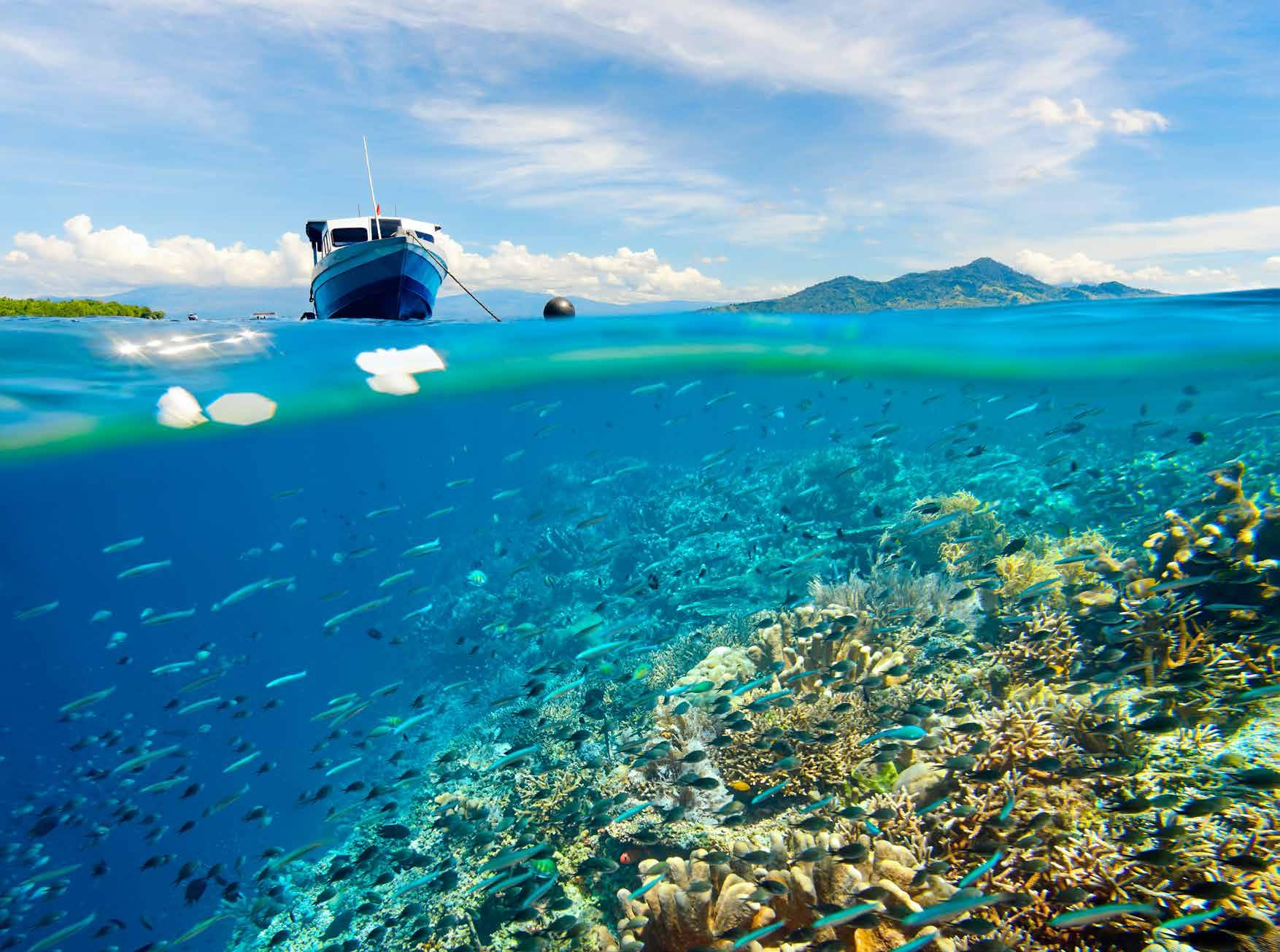
ABOUT THE AUTHOR:
Nora is a Biodiversity Specialist and Sustainability Scientist at Tunley whilst currently conducting a PhD, at the University of St. Andrews, on "understanding the role of lipids on coral biomineralisation and the effects of future climate change". To address her PhD research project, she has been conducting a wide range of experimental work, cultured coral under different temperatures, and has performed a fieldwork experiment at the CRIOBE research station in Mo'orea, French Polynesia. Overall, the aim of this research is to elucidate the effects of different lipid biomolecules on how corals build their CaCO3 skeletons and explore the resistance and resilience of coral to future climate change scenarios.
ABOUT THE COMPANY:
Tunley Environmental is made up of an impressively diverse team of PhD-level scientists who bring extensive knowledge and expertise to their services. This comprehensive understanding enables the company to provide innovative and scientific solutions at the highest level for clients. Tunley Environmental is wholly committed to the decarbonisation of the Earth. Their science-based approach and commercial aptitude ensure they identify realistic opportunities to reduce organisations' and products' negative impact on the environment.
Find out more on the company's website
1. Nature Positive (2024). Nature Positive – A Global Goal for Nature. Retrieved from https://www.naturepositive.org/
2. United Nations (2024). United Nations Sustainable Development - Goals and Targets. Retrieved from https:// sdgs.un.org/goals
3. UK Government (2024). Biodiversity Net Gain. Retrieved from https://www.gov.uk/government/collections/biodiversitynet-gain
4. UK Government (2024). Consultation on the Principles of Marine Net Gain. Retrieved from https://www.gov.uk/ government/consultations/consultation-on-the-principles-ofmarine-net-gain/outcome/government-response
5. Hooper, T., Austen, M., and Lannin, A. (2021). Developing policy and practice for marine net gain. Journal of Environmental Management, 277(111387), 0301-4797.
6. Hoegh-Guldberg, O., Cai, R., Brewer, P., Fabry, V., Hilmi, K., Jung, S., et al. (2014). “The ocean,” in Climate Change 2014: Impacts, Adaptation, and Vulnerability. Part B: Regional Aspects. Contribution of Working Group II to the Fifth Assessment Report of the Intergovernmental Panel on Climate Change, eds C. B. Field, V. R. Barros, D. J. Dokken, K. J. Mach, M. D. Mastrandrea, T. F. Bilir et al. (New York, NY: Cambridge University Press), 1655–1731
7. Gattuso, J. P., Magnan, A. K., Bopp, L., Cheung, W. W., Duarte, C. M., Hinkel, J., ... & Rau, G. H. (2018). Ocean solutions to address climate change and its effects on marine ecosystems. Frontiers in Marine Science, 5, 410554.
8. Sumaila, U., & Tai, T. (2020). End Overfishing and Increase the Resilience of the Ocean to Climate Change.
9. Danovaro, R., Aronson, J., Cimino, R., Gambi, C., Snelgrove, P., & Dover, C. (2021). Marine ecosystem restoration in a changing ocean. Restoration Ecology, 29.
10. Valdez, S., Zhang, Y., Heide, T., Vanderklift, M., Tarquinio, F., Orth, R., & Silliman, B. (2020). Positive Ecological Interactions and the Success of Seagrass Restoration, Frontiers in Marine Science, 7.
11. Williams, C., Rees, S., Sheehan, E., Ashley, M., & Davies, W. (2022). Rewilding the Sea? A Rapid, Low Cost Model for Valuing the Ecosystem Service Benefits of Kelp Forest Recovery Based on Existing Valuations and Benefit Transfers. Frontiers in Ecology and Evolution, 10.
12. Groombridge, B., & Jenkins, M. (2002). World atlas of biodiversity: earth's living resources in the 21st century. Univ of California Press.
13. https://news.un.org/pages/lungs-of-our-planet/
14. Halpern, B., Walbridge, S., Selkoe, K., Kappel, C., Micheli, F., D'Agrosa, C., Bruno, J., Casey, K., Ebert, C., Fox, H., Fujita, R., Heinemann, D., Lenihan, H., Madin, E., Perry, M., Selig, E., Spalding, M., Steneck, R., & Watson, R. (2008). A Global Map of Human Impact on Marine Ecosystems. Science, 319, 948 - 952.
15. Gaspar, M., Carvalho, S., Cúrdia, J., Santos, M., & Vasconcelos, P. (2011). 10.08 – Restoring Coastal Ecosystems from Fisheries and Aquaculture Impacts. Treatise on Estuarine and Coastal Science, 10, 165-187.
16. Williams, S., Ambo-Rappe, R., Sur, C., Abbott, J., & Limbong, S. (2017). Species richness accelerates marine ecosystem restoration in the Coral Triangle. Proceedings of the National Academy of Sciences, 114, 11986 - 11991.
17. Guannel, G., Arkema, K., Ruggiero, P., & Verutes, G. (2016). The Power of Three: Coral Reefs, Seagrasses and Mangroves Protect Coastal Regions and Increase Their Resilience. PLoS ONE, 11.
18. Mcleod, E., Chmura, G. L., Bouillon, S., Salm, R., Björk, M., Duarte, C. M., ... & Silliman, B. R. (2011). A blueprint for blue carbon: toward an improved understanding of the role of
vegetated coastal habitats in sequestering CO2. Frontiers in Ecology and the Environment, 9(10), 552-560.
19. Chan, W., Peplow, L., & Oppen, M. (2019). Interspecific gamete compatibility and hybrid larval fitness in reef-building corals: Implications for coral reef restoration. Scientific Reports, 9. 20. Schulte, D., Burke, R., & Lipcius, R. (2009). Unprecedented Restoration of a Native Oyster Metapopulation. Science, 325, 1124 - 1128.
21. Da Ros, Z., Corinaldesi, C., Dell'Anno, A., Gambi, C., Torsani, F., & Danovaro, R. (2021). Restoration of Cymodocea nodosa seagrass meadows: Efficiency and ecological implications. Restoration Ecology, 29, e13313.
22. Orth, R., Lefcheck, J., McGlathery, K., Aoki, L., Luckenbach, M., Moore, K., Oreska, M., Snyder, R., Wilcox, D., & Lusk, B. (2020). Restoration of seagrass habitat leads to rapid recovery of coastal ecosystem services. Science Advances, 6. 23. https://sciencebasedtargetsnetwork.org/companies/ take-action/
24. https://naturalengland.blog.gov.uk/2023/12/11/governmenttakes-a-step-forward-for-marine-nature-recovery/
25. Greaves, D., Attrill, M., Chadwick, A., Conley, D., Eccleston, A., Hosegood, P., Pan, S., Reeve, D., Williams, J., Wolfram, J., Xu, J., Zou, Q., Smith, G., Godley, B., Hor, C., Johanning, L., Millar, D., Zobaa, A., Belmont, M., & Harrington, N. (2009). Marine renewable energy development – research, design, install. Maritime Engineering, 162, 187-196.
26. Lamy, J., & Azevedo, I. (2018). Do tidal stream energy projects offer more value than offshore wind farms? A case study in the United Kingdom. Energy Policy, 113, 28-40.
27. Slorach, P., Crossland, I., Silva, A., & Money, N. (2023). Renewables for Subsea Power – Transformational Low Carbon Subsea Power Project.
28. Epstein G, Roberts CM (2022) Identifying priority areas to manage mobile bottom fishing on seabed carbon in the UK. PLOS Clim 1(9): e0000059
29. Koh, L. P., Dunn, R. R., Sodhi, N. S., Colwell, R. K., Proctor, H. C., & Smith, V. S. (2004). Species coextinctions and the biodiversity crisis. Science, 305(5690), 1632-1634.
30. Sandor, M. E., Elphick, C. S., & Tingley, M. W. (2022). Extinction of biotic interactions due to habitat loss could accelerate the current biodiversity crisis. Ecological Applications, 32(6), e2608.
31. Meehan, A. J., & West, R. J. (2002). Experimental transplanting of Posidonia australis seagrass in Port Hacking, Australia, to assess the feasibility of restoration. Marine Pollution Bulletin, 44(1), 25-31.
32. Chou, L. M. (2006). Marine habitats in one of the world’s busiest harbours. In The environment in Asia Pacific harbours (pp. 377-391). Dordrecht: Springer Netherlands.
33. Johnston, E., Marzinelli, E., Wood, C., Speranza, D., & Bishop, J. (2011). Bearing the burden of boat harbours: heavy contaminant and fouling loads in a native habitat-forming alga. Marine pollution bulletin, 62 10, 2137-44.
34. Bayraktarov, E., Saunders, M.I., Abdullah, S., Mills, M., Beher, J., Possingham, H.P., Mumby, P.J. and Lovelock, C.E. (2016), The cost and feasibility of marine coastal restoration. Ecol Appl, 26: 1055-1074.
35. https://www.gov.uk/guidance/creating-a-habitatmanagement-and-monitoring-plan-for-biodiversity-net-gain